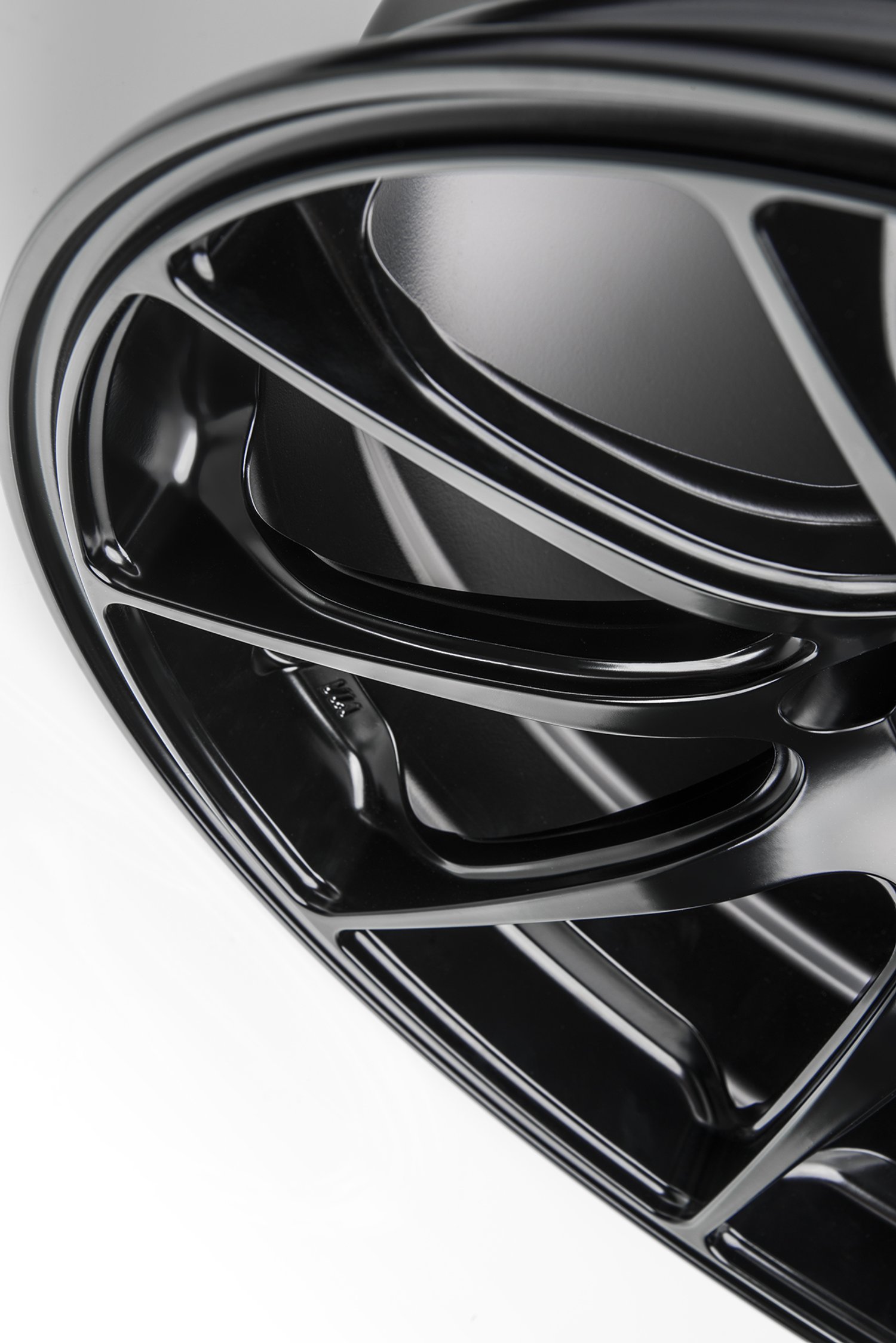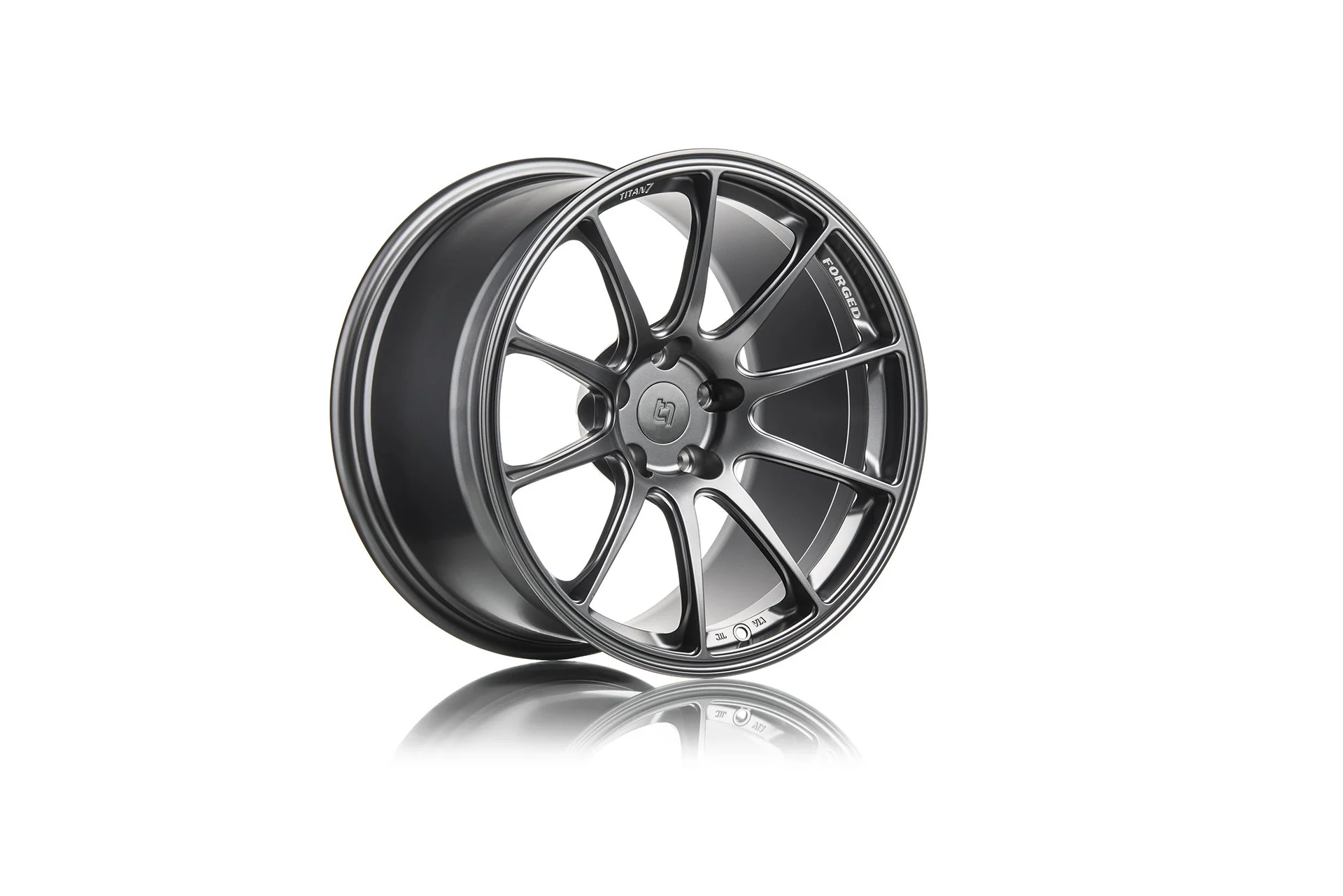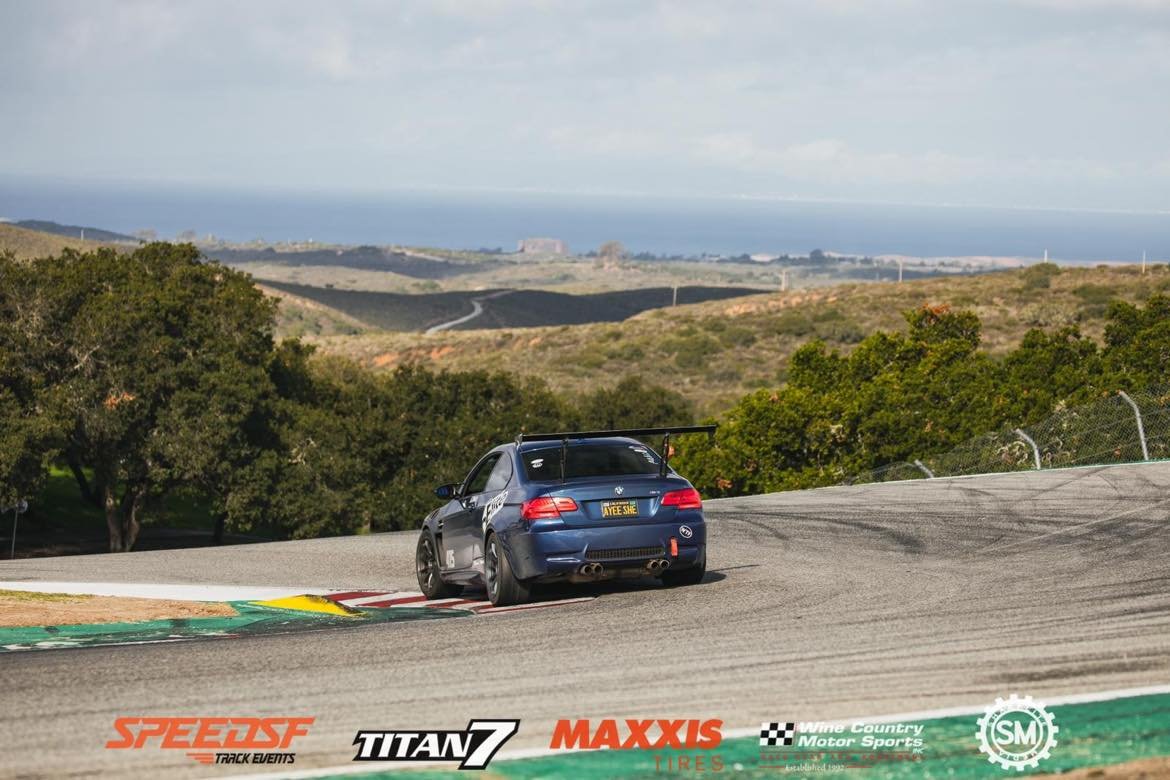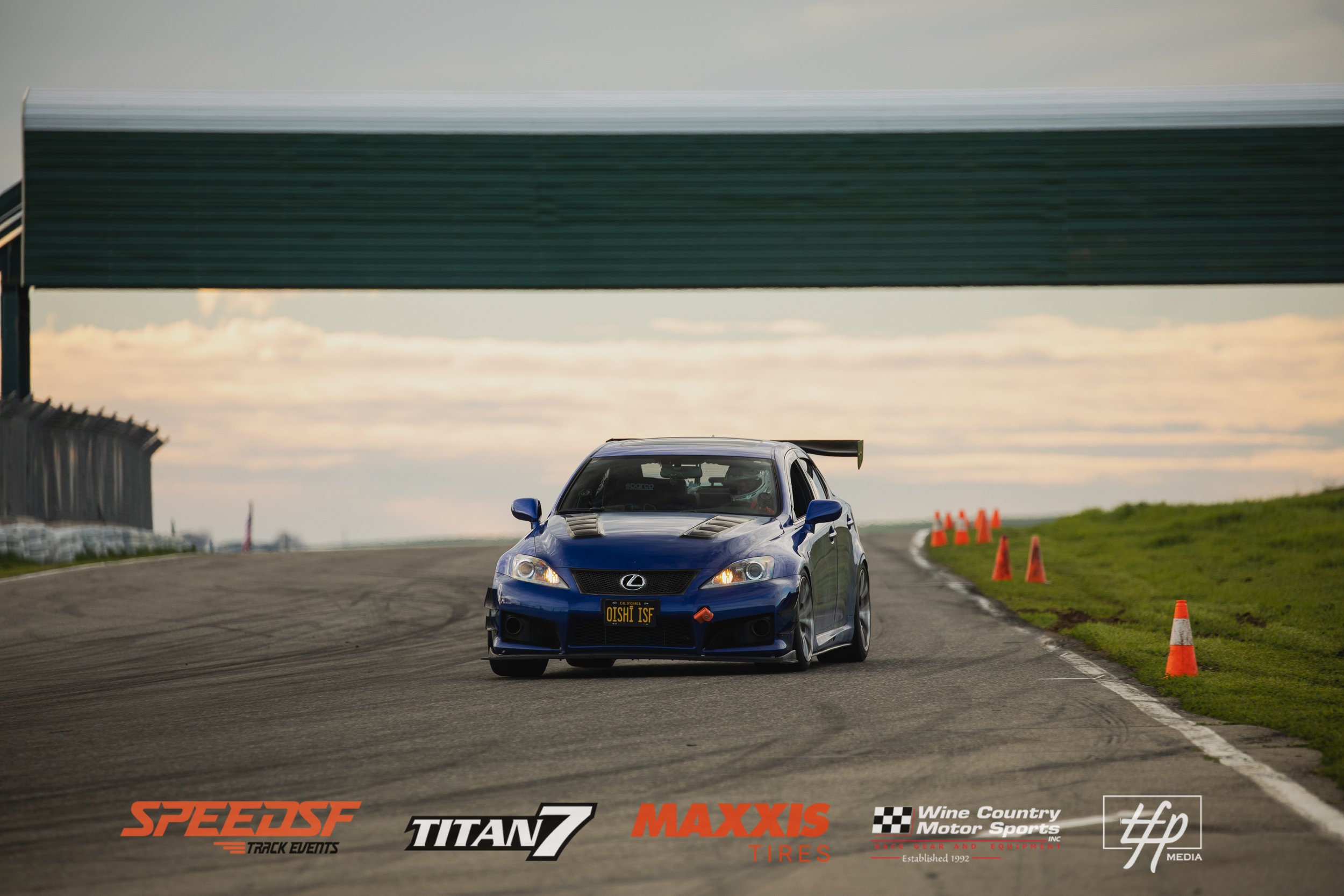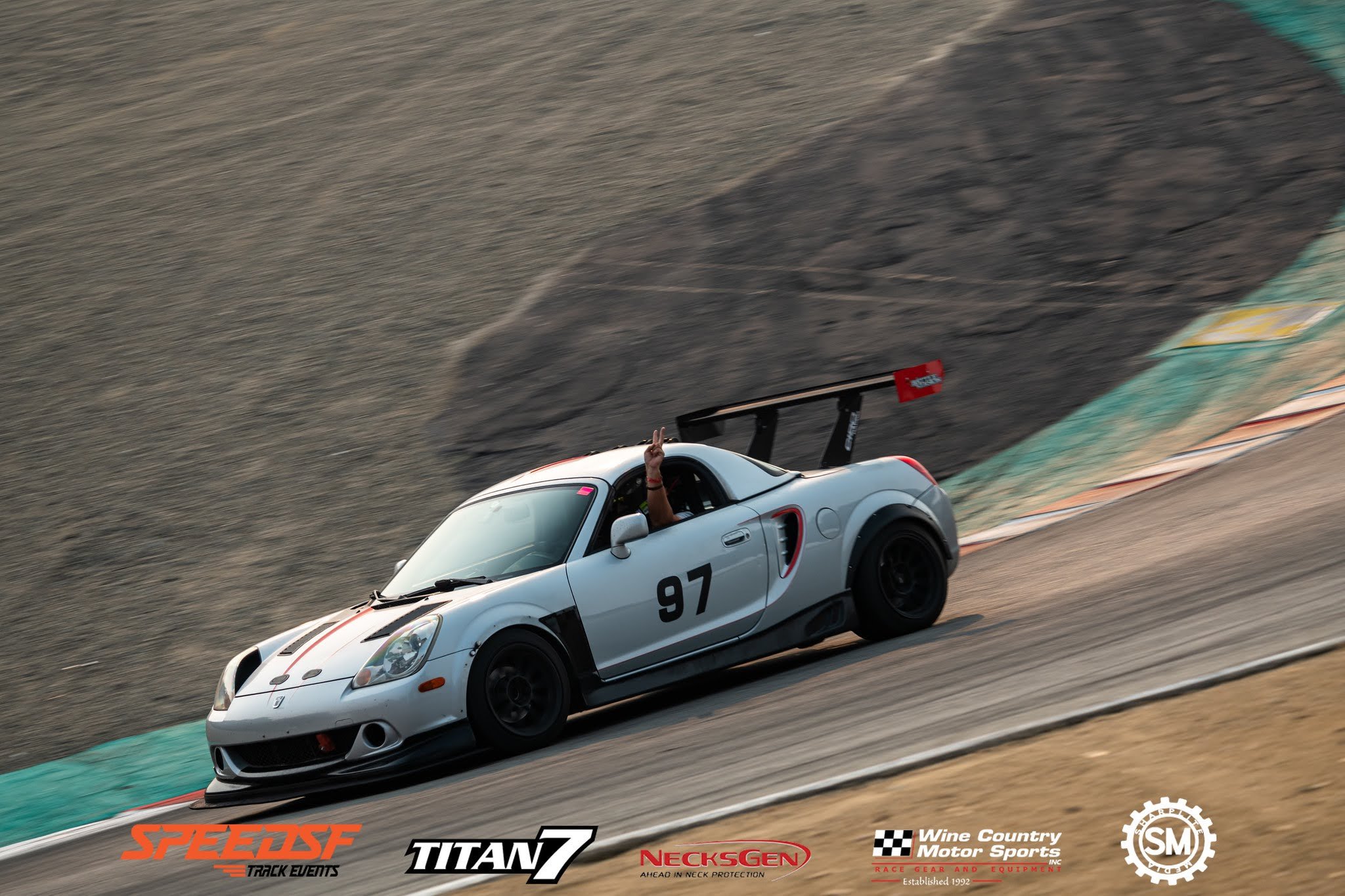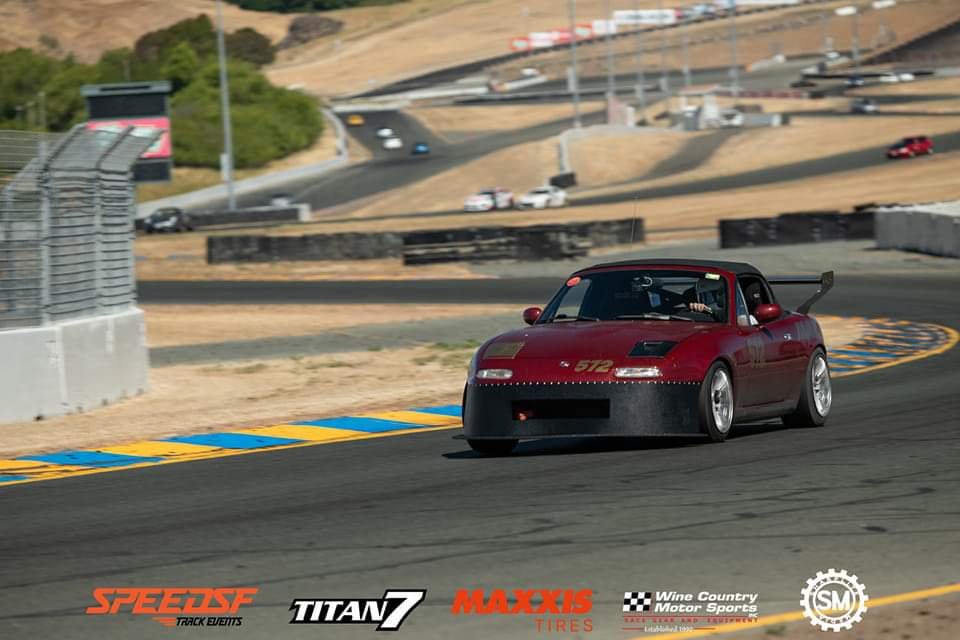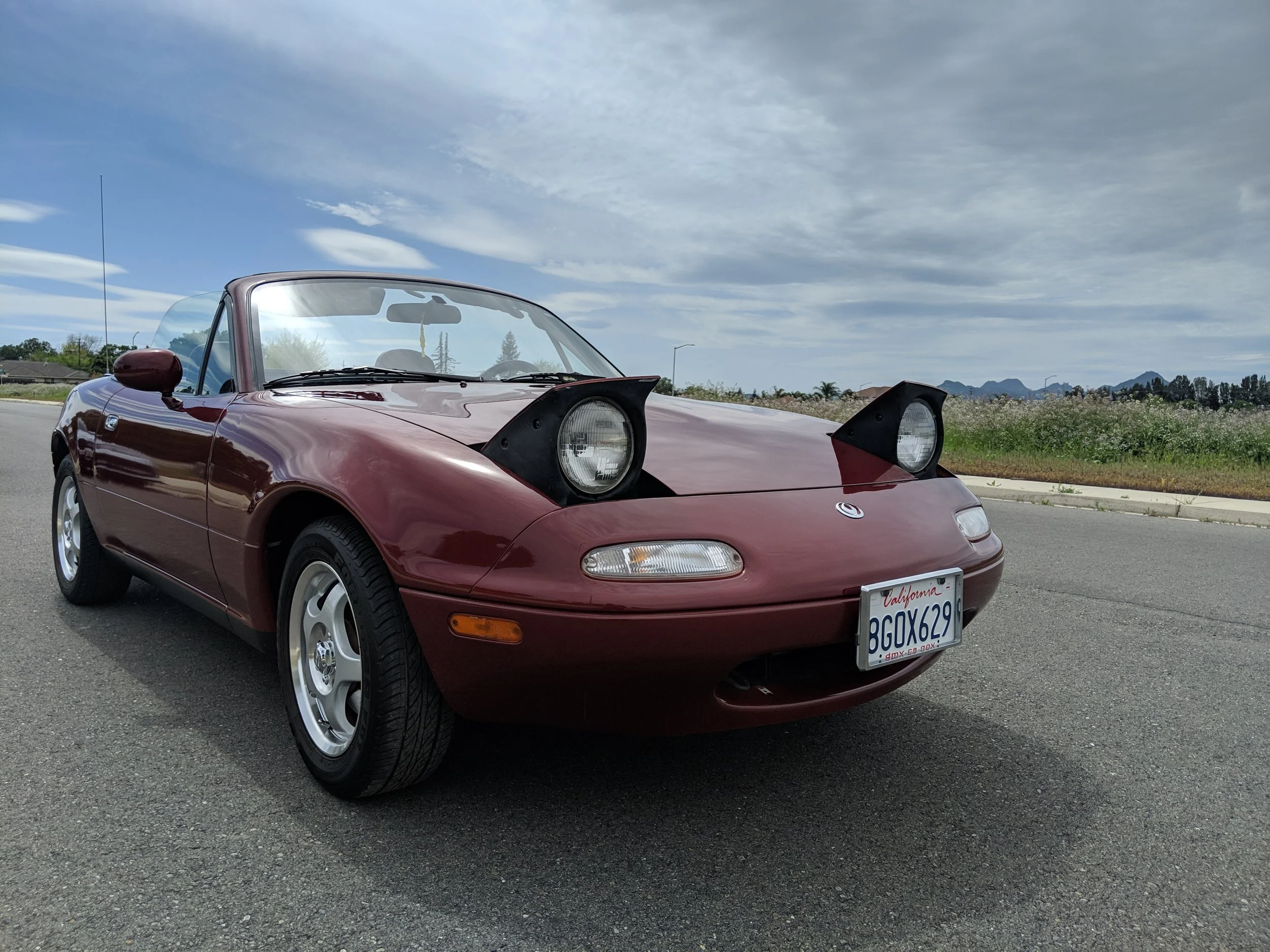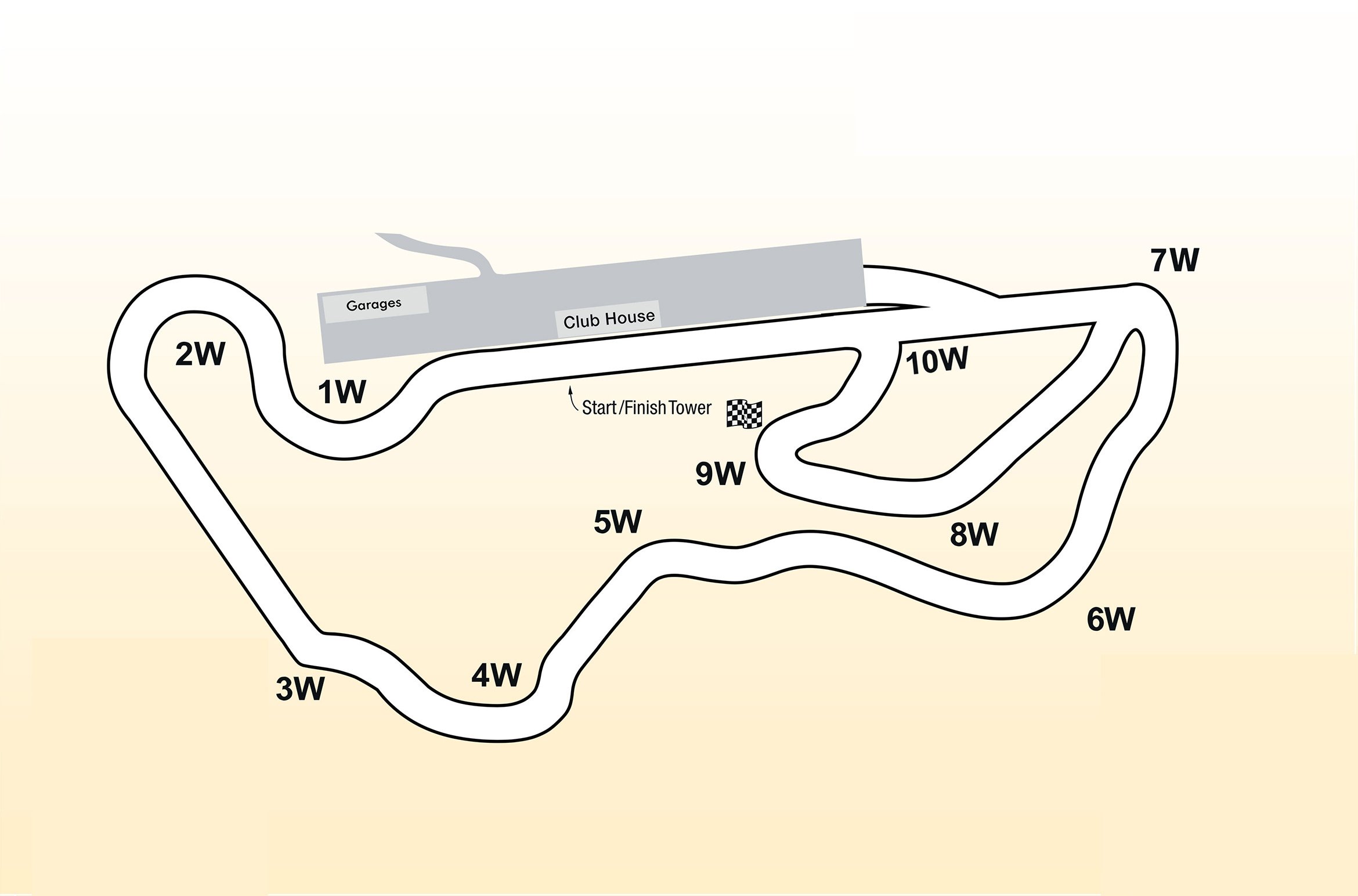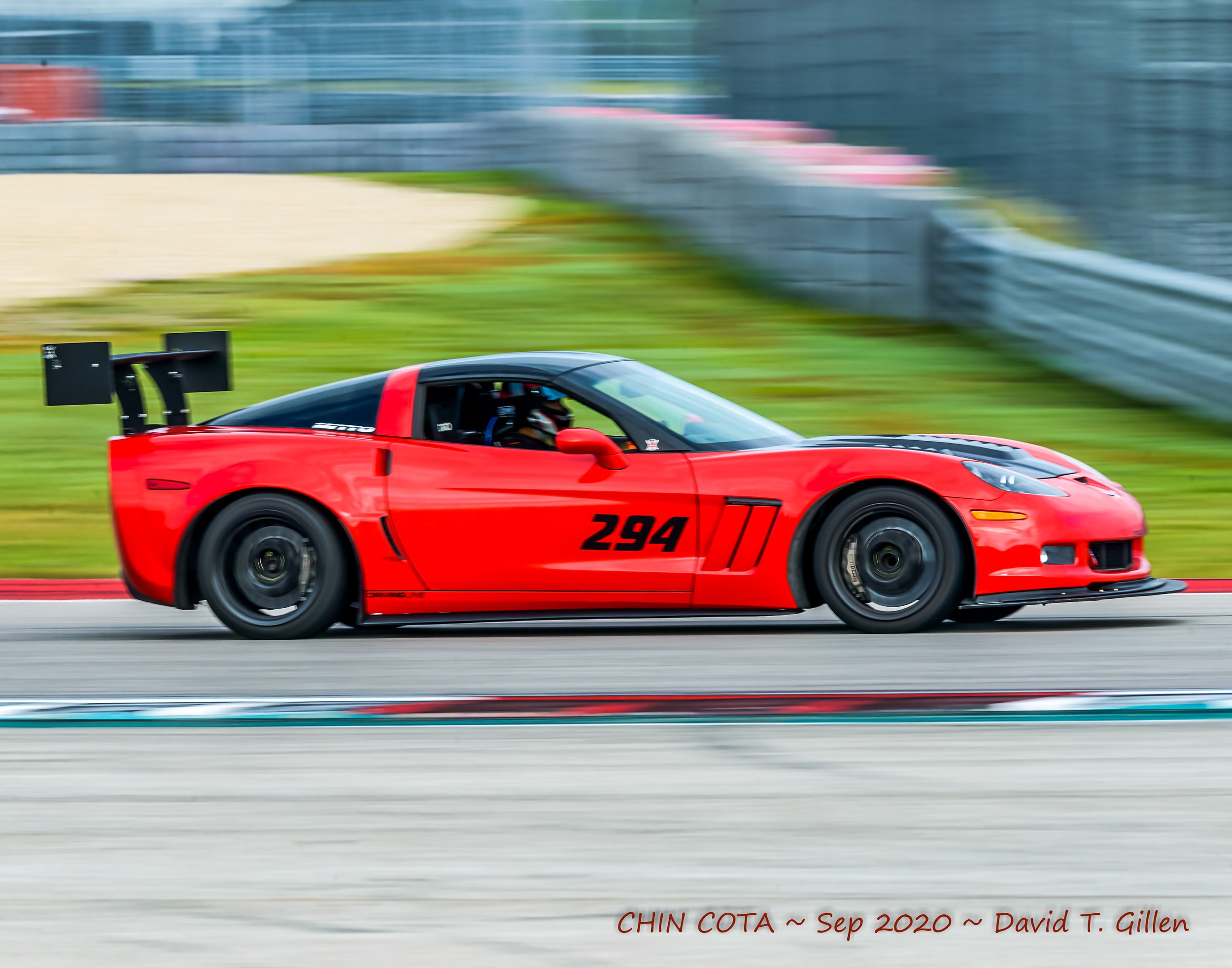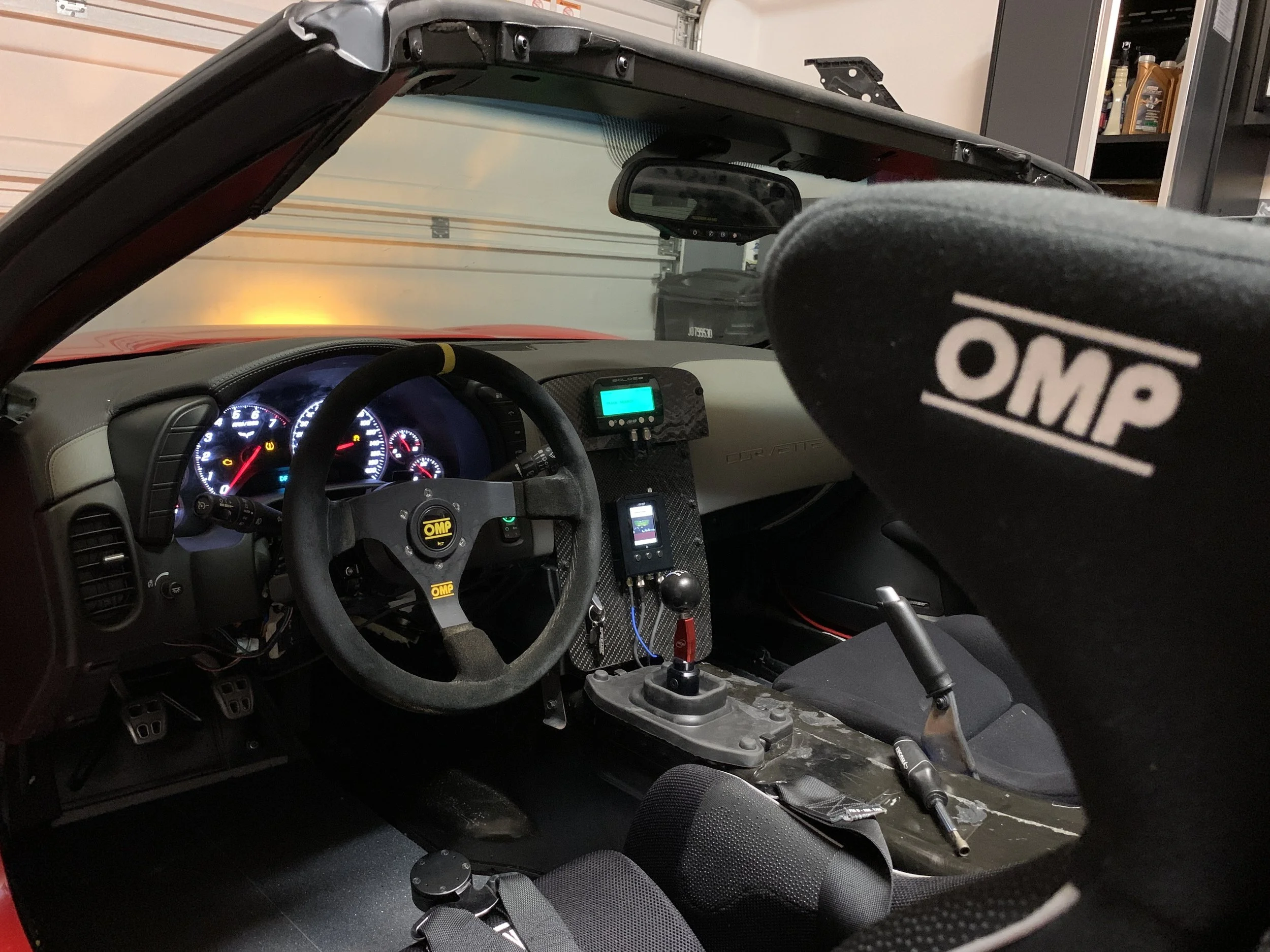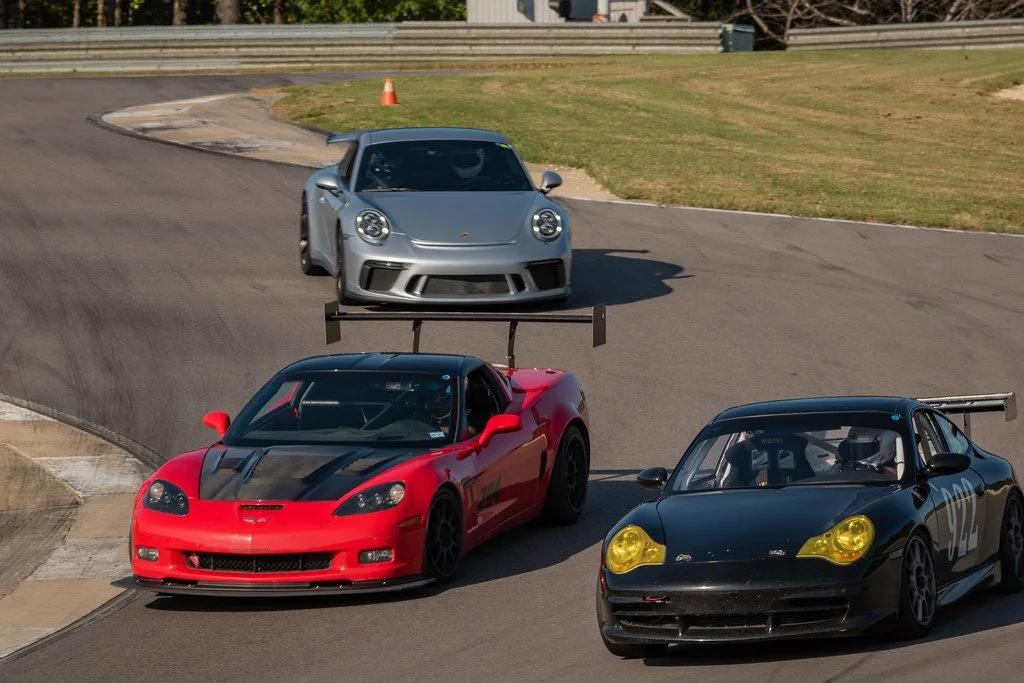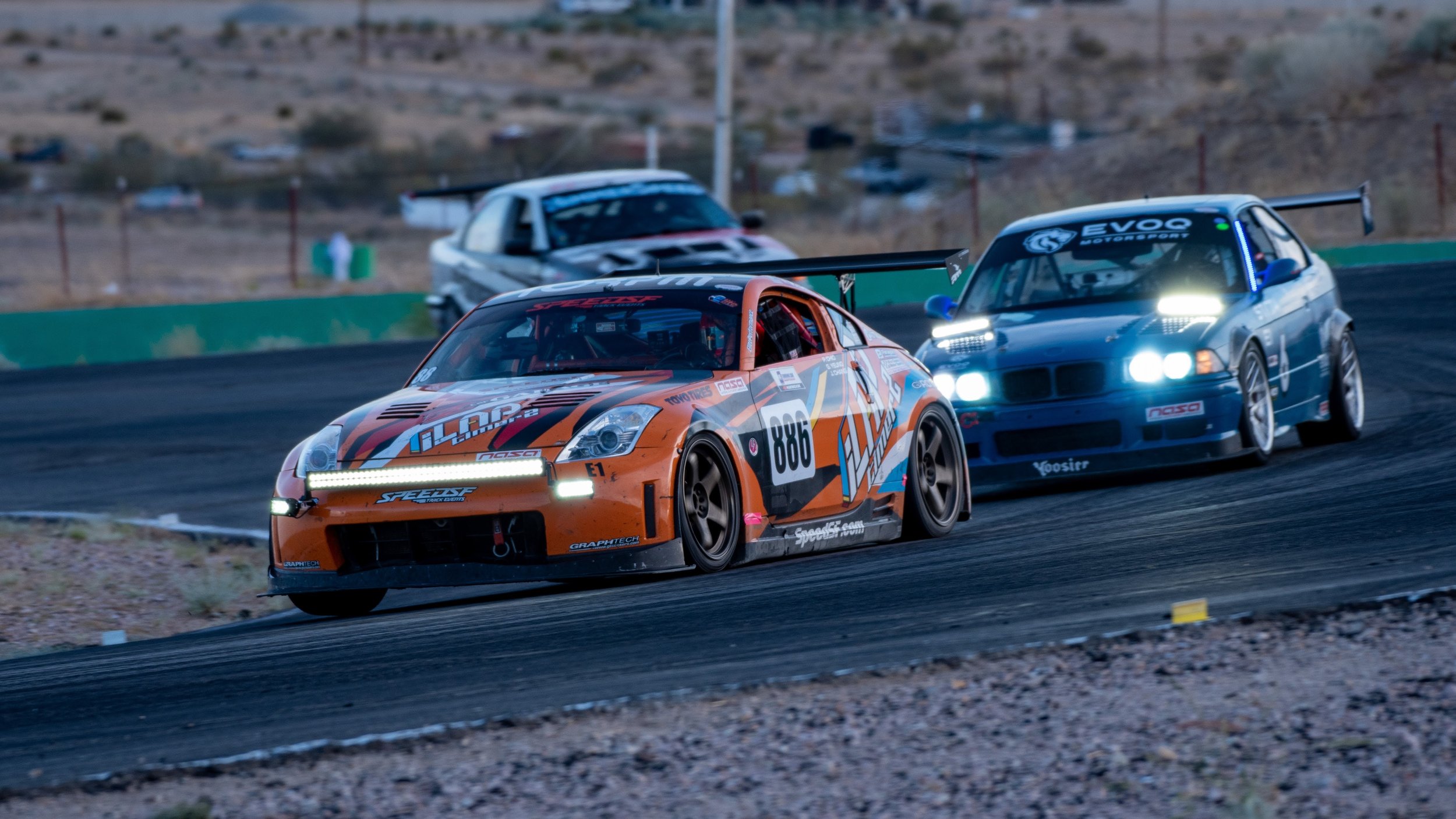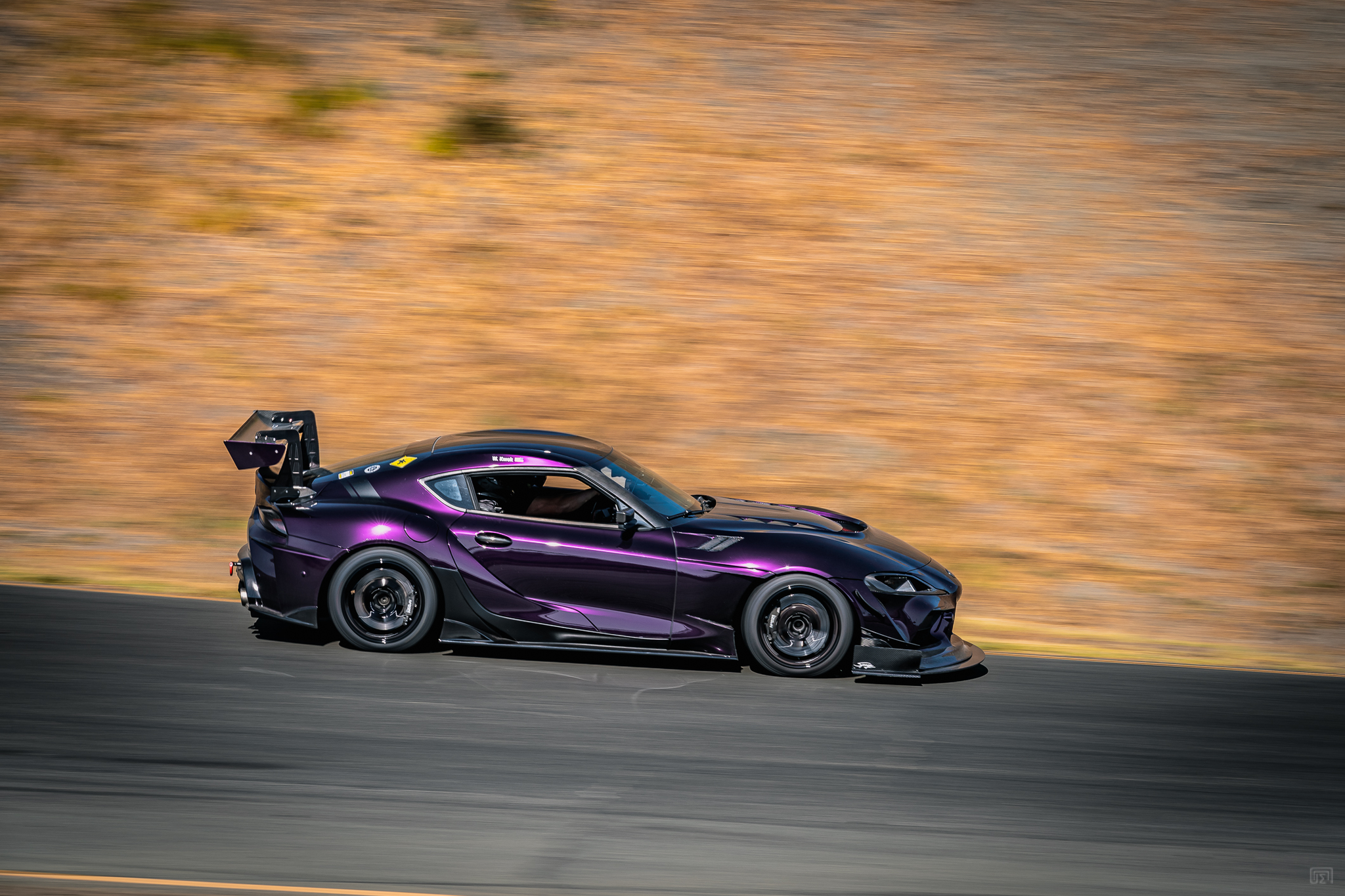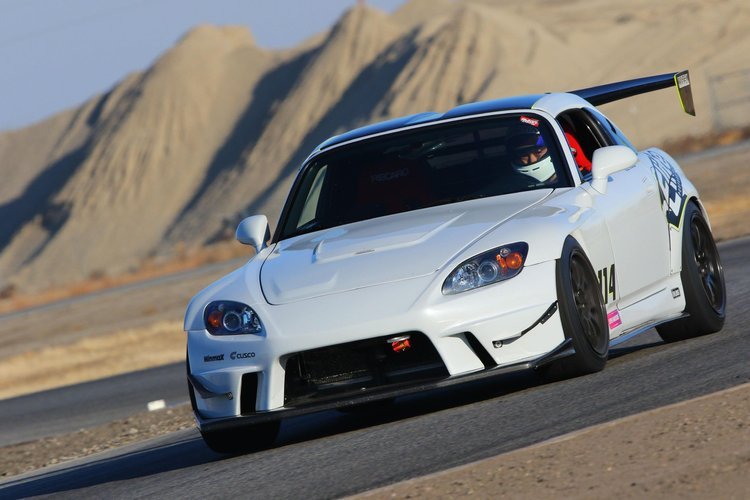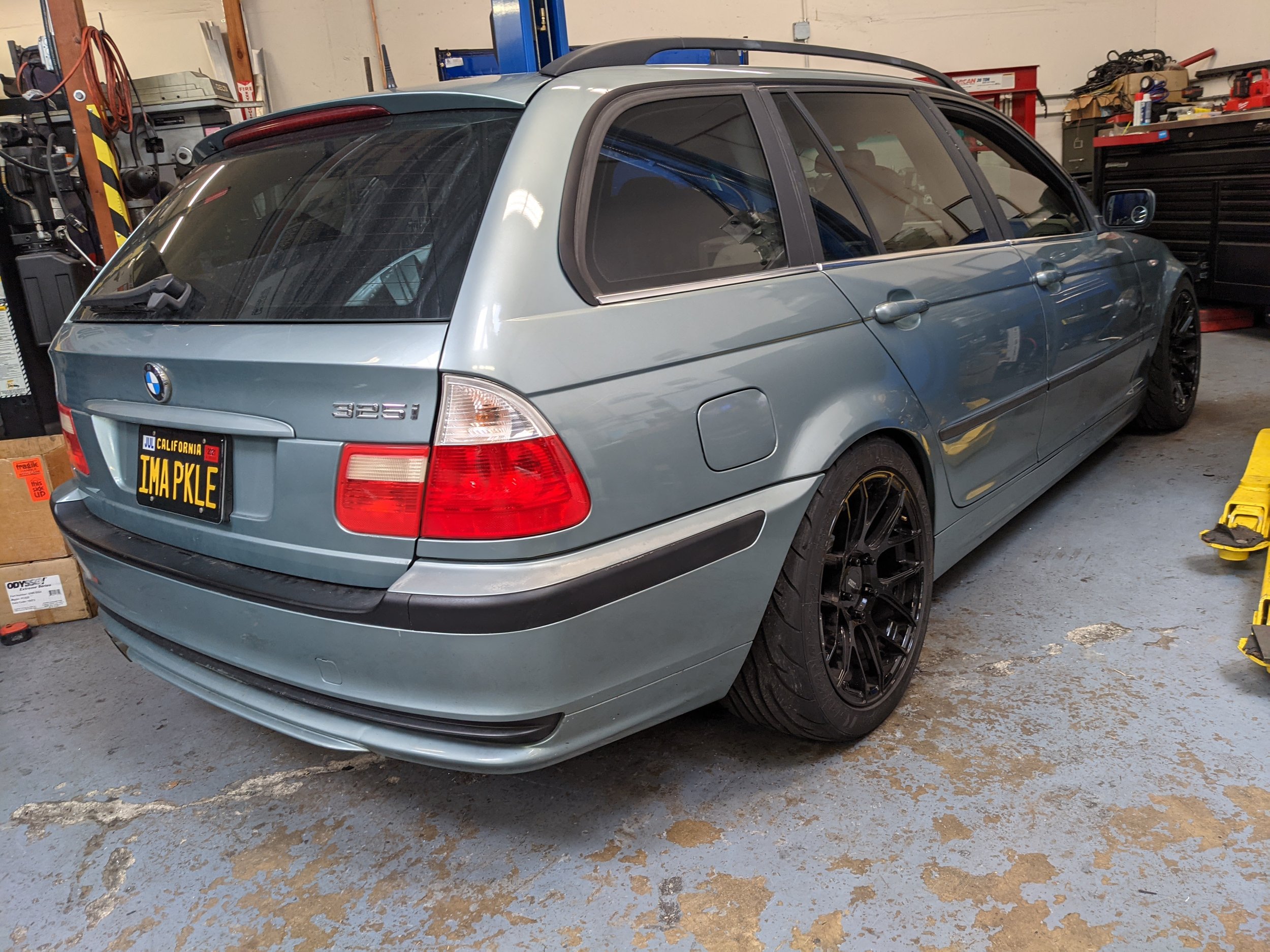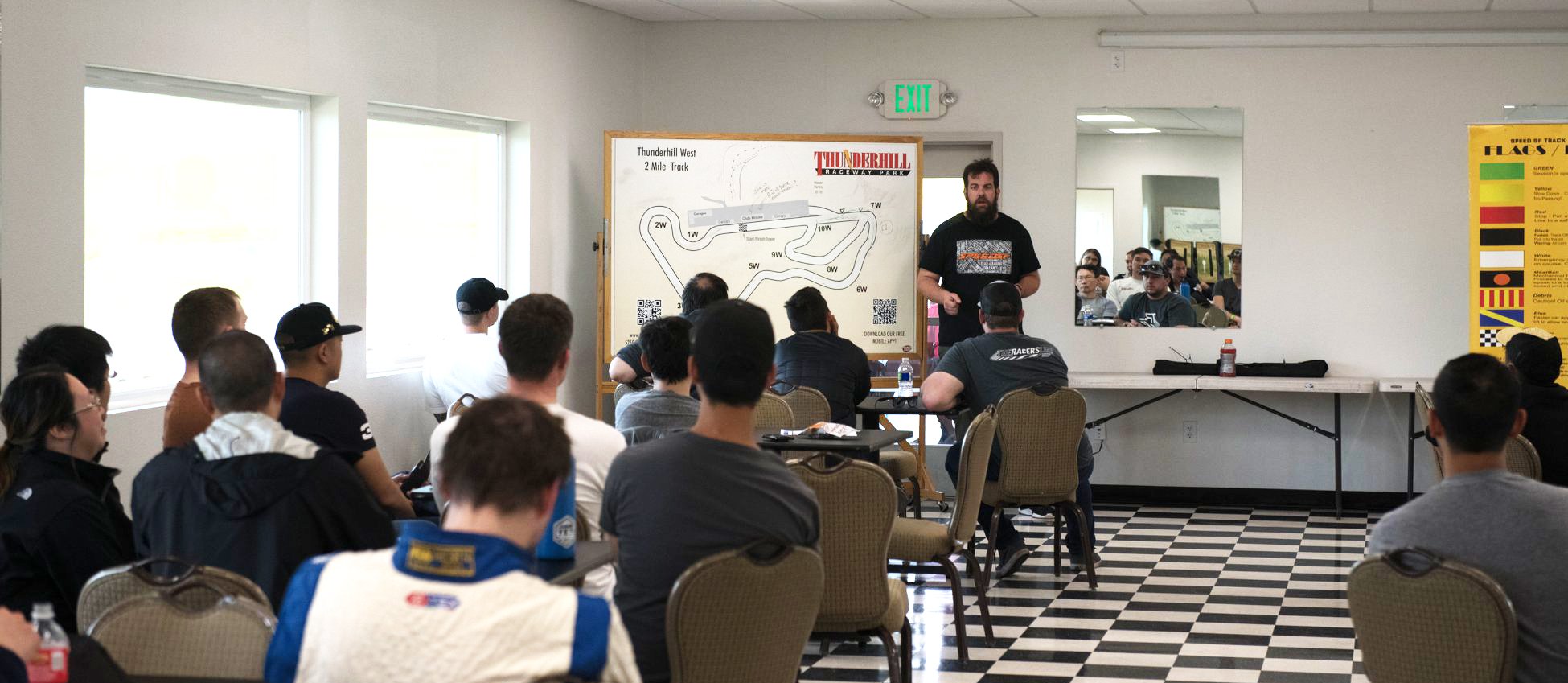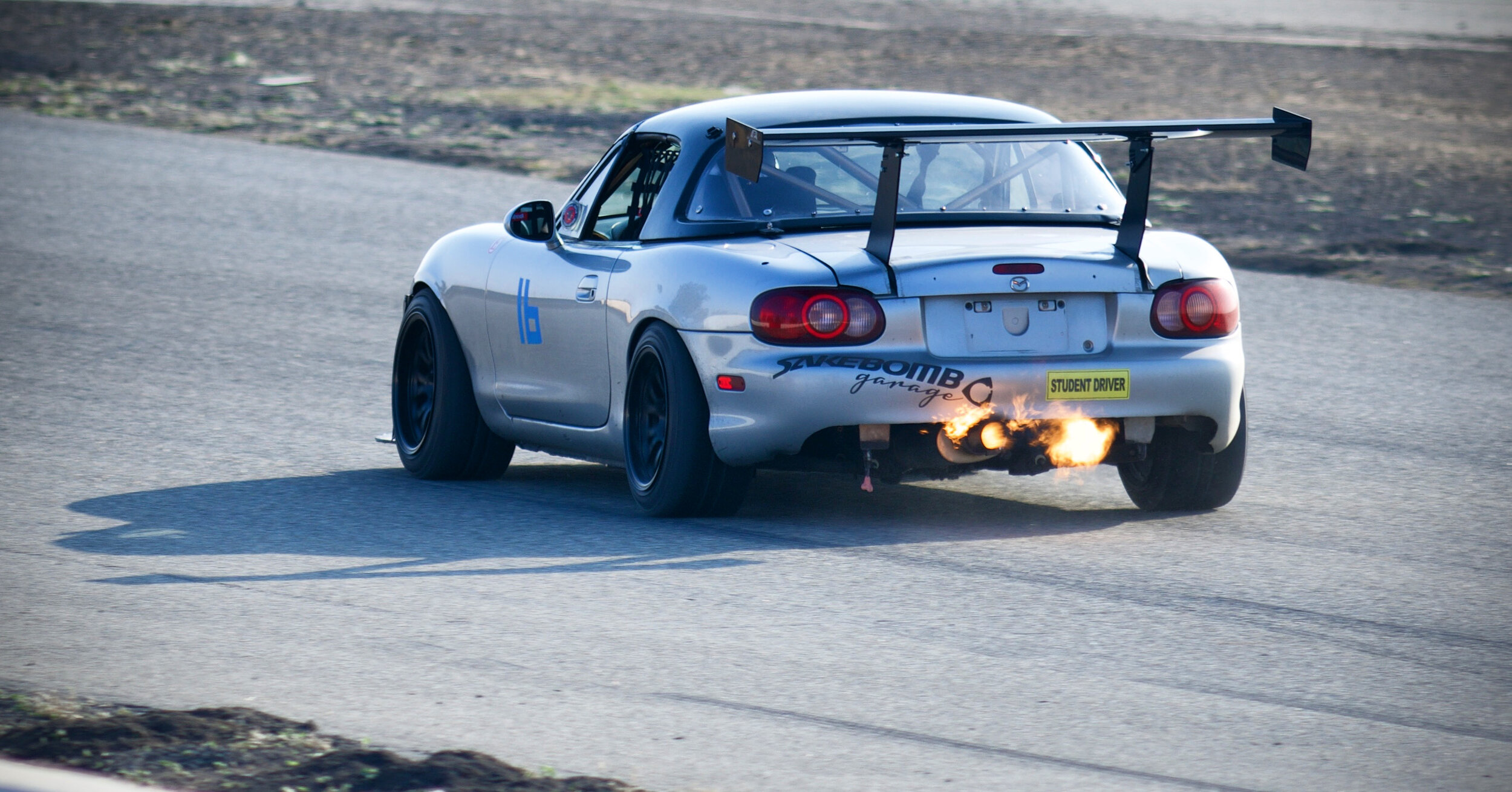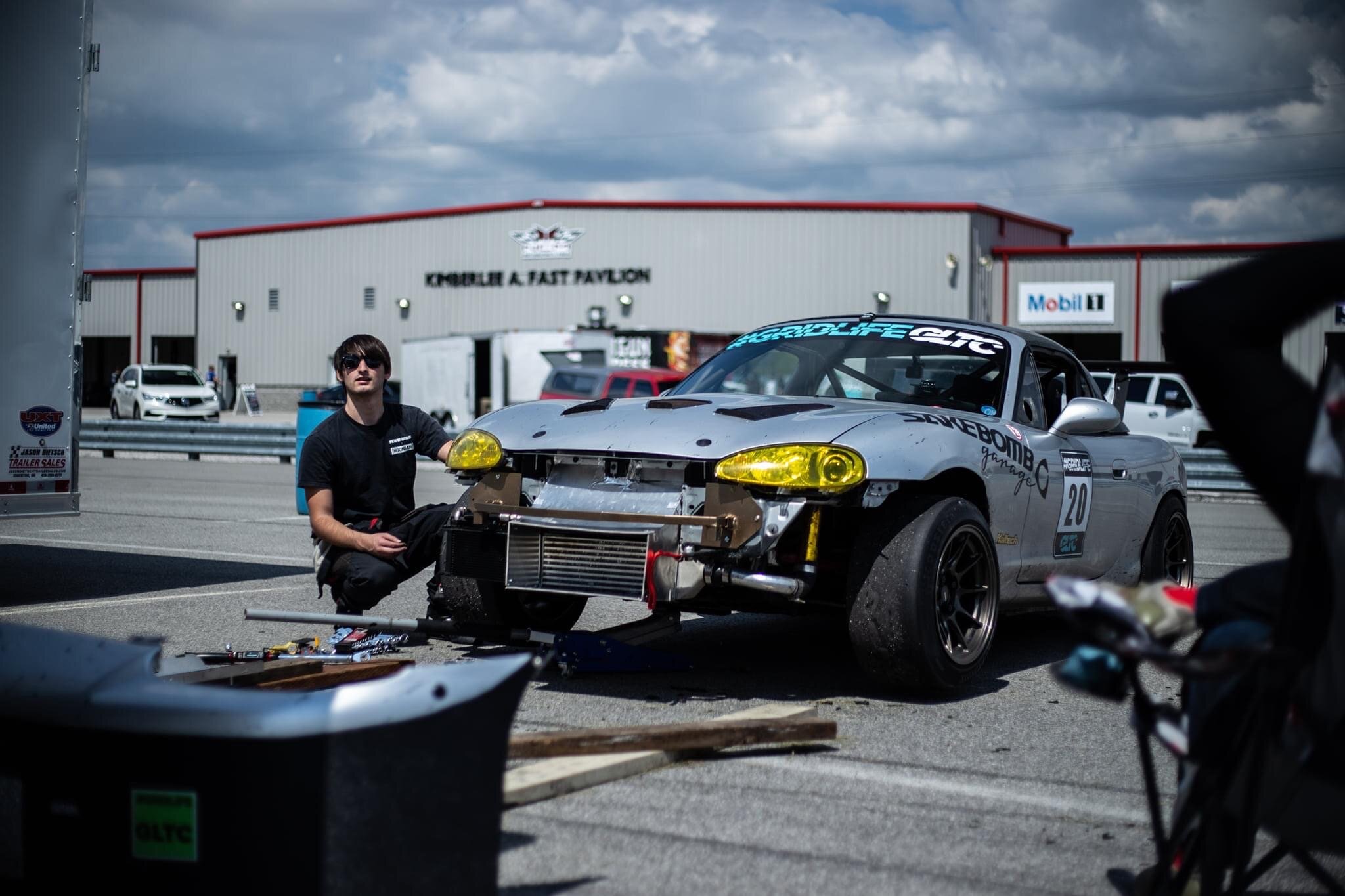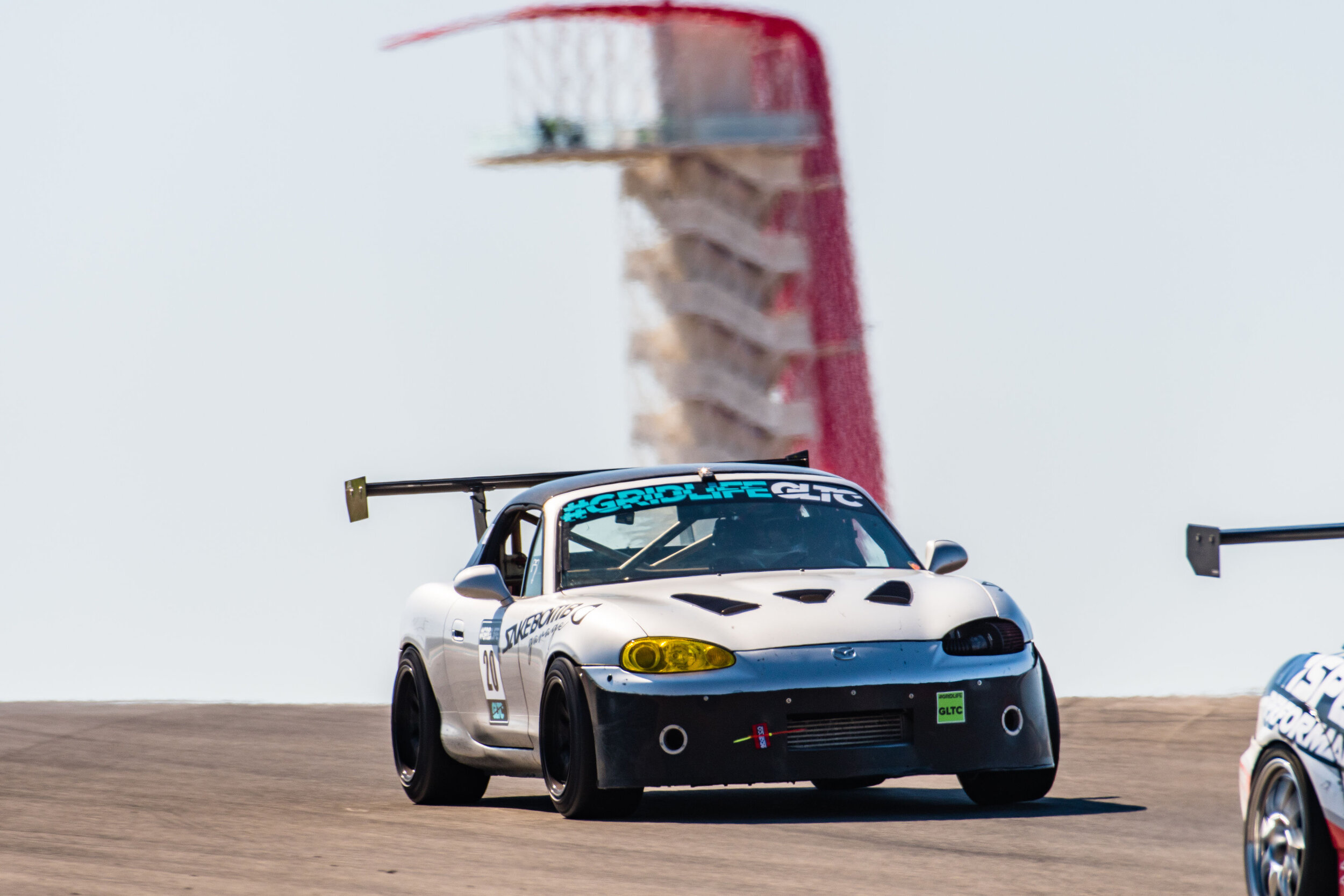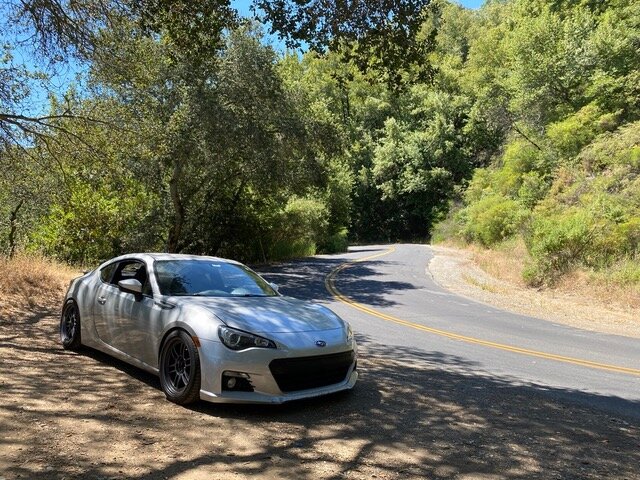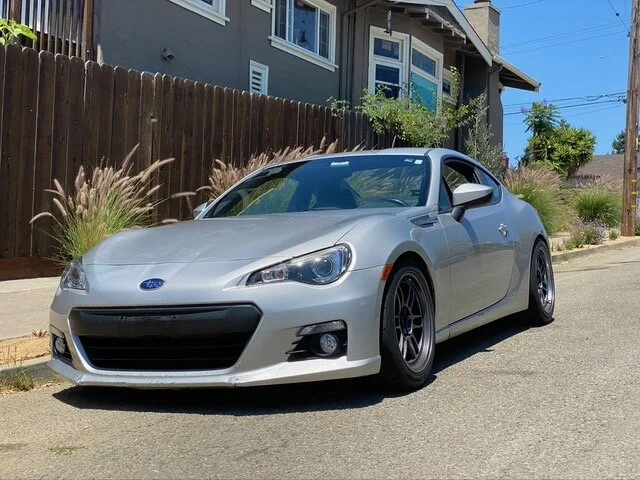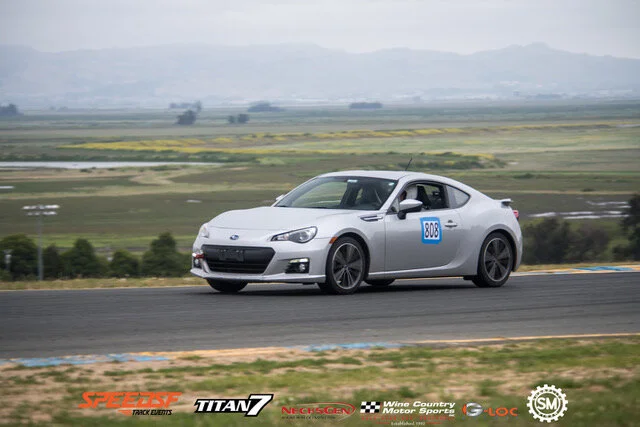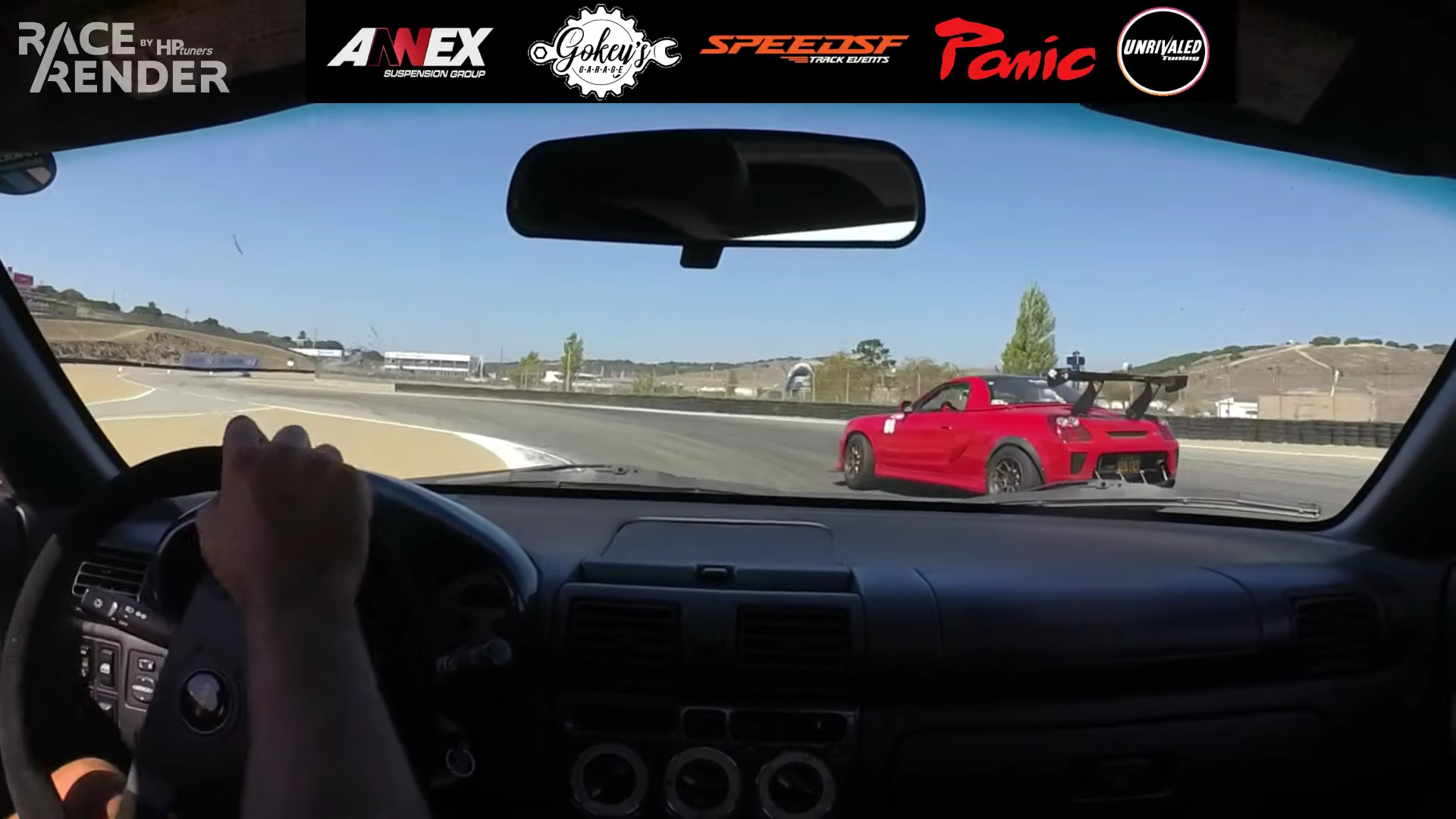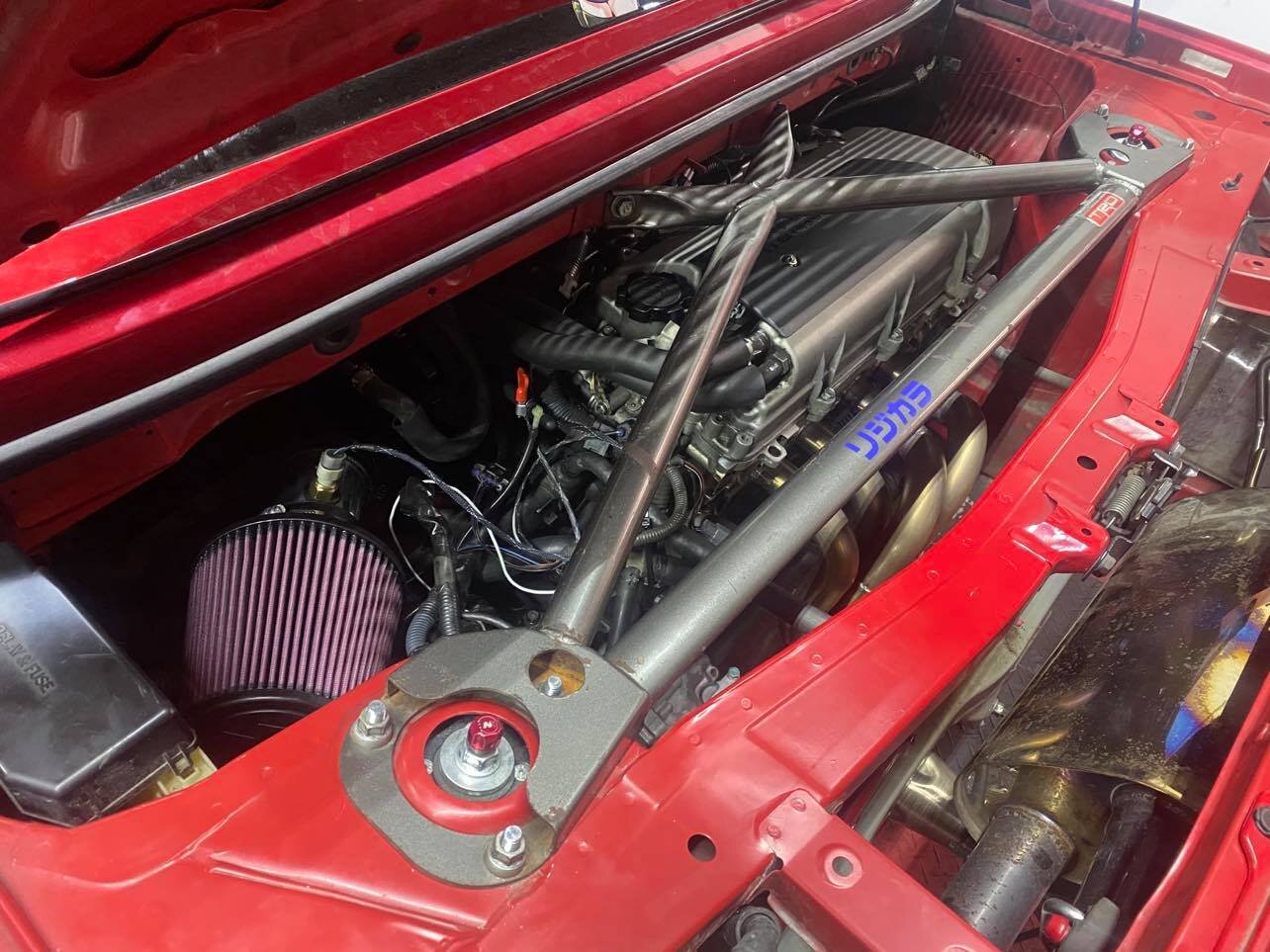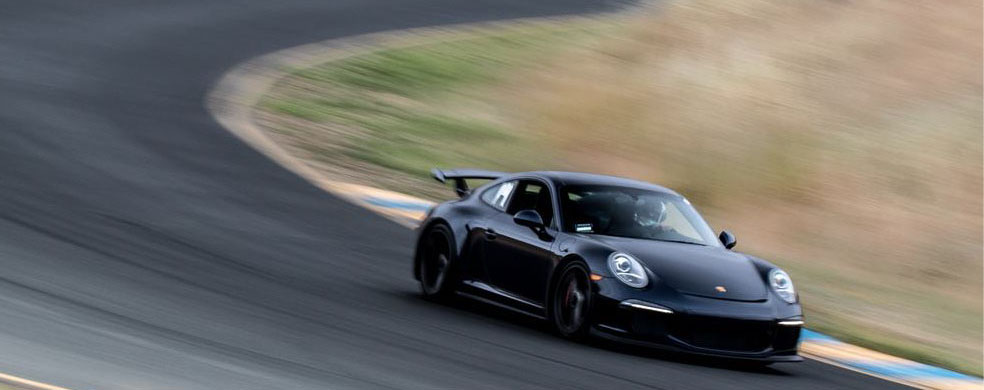
Titan 7's Approach to Building a Racing Wheel: No Corners Cut
To get the most resilience needed to withstand track abuse, Titan 7 takes a special approach to designing their forged wheels.
Racing wheels are subjected to severe and specific forces on a regular basis. When designing their motorsports-oriented wheels, Titan 7 takes clubbing curbs, dropping wheels off track, rubbing against other wheels and other forms of racing-related abuse into consideration.
Though this is a relatively short list of demands when compared to considerations one must make when designing a road-oriented wheel, they must live up to exacting standards their less-stressed siblings don’t have to. In other words, the increased loading and concentrated forces acting on them mean these wheels need to be built to an unusually high standard.
To attain the necessary sturdiness, Titan 7 puts their forged wheels through a grueling testing procedure which assesses corner fatigue, radial fatigue, drum endurance, and resistance to impacting.
Let’s delve into one of these to illustrate how seriously Titan 7 pursues safety. Impact testing replicates situations most wheels will run into on a regular basis. In this test, Titan 7 drop a giant guillotine-like device set to a specific height and weight onto the wheel to simulate hitting potholes, nudging curbs, and other forms of real-world abuse.
The robustness of their forged wheels wouldn’t be possible without the right foundation. Each wheel begins as a solid cylinder of aircraft-grade 6061 aluminum. They pressurize the cylinder with 10,000 tons of pressure to give the wheel its basic shape while improving the grain structure and overall properties of the high grade aluminum.
This means that porosity, a critical factor in track-oriented wheels, is minimized in the case of flow-formed wheels, and completely negated with forged wheels. Minimizing or negating porosity is crucial—a tiny air bubble or two may become the epicenter of a serious crack after plenty of curb hopping and weight shifting. In the case of the forged wheel, having no porosity and a densely organized microstructure allows for amazing designs, weight, and strength.
All of Titan 7’s wheels feature knurling on the inside of the bead to better grasp the tire.
Consistency in handling is dependent on a few factors—stiffness is one of them. Improving stiffness is key because it reduces wheel deflection / deformation in high load situations, which improves vehicle predictability, which increases driver confidence.
As big of a role as stiffness plays, Weight is one of the more crucial elements in a racing car as unsprung mass—too much of it—seriously handicaps roadholding and consistency with the contact patch.
Titan 7 put a great deal of importance on this aspect and works to trim as much material as possible while keeping material in critical areas to ensure complete safety and reliability.
For instance, TItan 7 decided that machining out the pockets on the back pad of wheels was worth the additional cost. Any safely removed mass means a performance improvement.
Weight reduction cannot be the only objective, though. As with anything that’s intended for such demanding use, its design must balance this against a few other aims. Therefore, it was decided that additional mass should be used around the inner rim flange to better absorb impacts and resist bending. Even if this added to the weight of the wheel, it helped ensure the sturdiness a track-oriented piece of hardware should have.
It’s not one area of performance which is prioritized with Titan 7’s forged wheels. They look at the big picture.
Steve Chi's M3: The Natural
After crashing his FR-S, Steve Chi moved into a car with twice the power.
Steve Chi followed a long, sinuous path through motorsports before he started spending most of his weekends at the track. His salad days of drag racing and with import scene of the late 1990s featured a list of interesting cars—a heavily stickered Integra and a touge-tuned EG at the top of list. After a decade of teenage hooliganism eventually put him in touch with some more serious-minded car nuts and encouraged him to step into a safer, more challenging avenue. One friend Ryan recommended he try Thunderhill in his then-new RSX Type-S.
The financial limitations at the time kept Steve from truly exploring the nuances of that chassis, but that one outing had planted the seed. Fast forward seven years, and he’d finally acquired the right car and the means necessary to frequent his local tracks.
The car was one of the best available for someone with his interests and experience. Sadly, this Scion FR-S was modified to the point of pointiness; it had a tendency to get a little too loose. During one day at Laguna, Steve fell prey to the deceptive shape of an increasing-radius corner, and to make matters worse, this corner tends to accumulate a lot of sand at the exit. By dropping a wheel at the exit of Laguna’s Turn 3, he drew a fifty-foot arc across the track and backed the Scion into the inner wall just underneath the bridge. Though he was fine, the impact was direct and enough to write the car off. It was also a lease.
Despite the drama, he wasn’t discouraged long and sought out a new car a few weeks later.
Keeping Things Natural
He’d been through faster front-drive and four wheel-drive platforms before his FR-S, but the engagement and playfulness of the Scion had stirred something up inside him. His hands were getting quicker, and though he was wary of the running costs of a powerful rear-drive car, he was curious.
He’d always wanted a M car, and seeing the way the price of the E46 M3 was growing, it seemed that the newer, heavier, and more powerful E92 was the way forward.
Truth be told, he wanted an E90: the four-door version of the last atmospheric M3 for stylistic reasons. Additionally, there weren’t many performance disadvantages—the weights are similar and, actually, the sedan’s slightly stiffer. However, the four-doors weren’t so easy to find, and after a month of scouring classifieds, he came upon an E92. This one had just two doors and the undesirable moonroof, but was nonetheless a clean car which tugged at Steve’s heartstrings.
So, despite Gary Wong urging him to wait for the ideal car, Steve took his new sedan home with him. Only once the honeymoon phase ended.did he start to consider the tire bill, though his fears were allayed by the promise of twice the power his FR-S going through the rear wheels.
“Gary wasn’t surprised by my decision—just disappointed,” Steve chuckled.
That power is enough to cause concern. Not because it causes snap oversteer or anything, but more the way it limits the lifespan of the tires—particularly the rears. While the FR-S would only destroy its tires after five track days, Steve can run through a set in just two days if he’s driving aggressively.
Thankfully for tire longevity, he S65 isn’t like a lot of comparably priced V8s on the market. Its powerband is best described as peaky; it displaces only four liters and most of the horsepower arrives well past 4,000 rpm. It does to 8,200, though. That peakiness helps with the power delivery, but the lack of torque to move that weight around leaves him wanting a little more. “It’s in a weird spot now,” Steve began,” either it needs another 100 horsepower, or it needs to lose 150 pounds.”
Not a Heifer
The car came to him at 3,730 pounds, but through a pretty stringent diet and some lightweight replacements here and there, he’s trimmed about 500 from the original number. A carbon blank-off filling in the moonroof space and panel-free doors add to the sense of occasion, the lack of rear interior increases the volume in the cabin, and a harness bar keeps him from storing too many tools and tires where the rear seats used to be.
If all these changes took little bites out of the car’s convenience, the removal of the roofliner stole a chunk—the removal of the liner took the visor mounts along with it. A track car worth its salt should render you deaf and blind over time.
There’s still some room for serious reduction without resorting to composites. The OEM exhaust’s still in place, as is the original battery. If those two are replaced with race-oriented parts, he could get nearer to his desired weight without spending outrageous money.
Read too many Colin Chapman quotes and you might think that weight is always the enemy, but this M3’s weight reduction program posed one major problem: the discomfort of the car was getting to be a bit much. The Ohlins R & T coilovers rode roughly and, worse yet, they made the car too nervous and excitable. In faster corners, he always felt the need to leave a lot in reserve.
However, it’s so often about optimization; these parts need to be tailored to different weights or driving styles to find a happy partnership. Sticking with the same brand, he upgraded to the TTX line with spring rates better suited to his lightened car. Now, even with solid mounts and poly bushings most places, the car is compliant and confidence inspiring. This car is not trailered and needs to be semi-streetable to get places.
Future Plans
Towards the start of the pandemic, Steve took a sabbatical from racing to start a family, but wisely kept the rust away with a basic sim rig. Once the kids had all gone to bed, he’d sneak away for a quick session.
By keeping himself sharp, he returned to tracking towards the end of last year and found his performance comparable if not slightly better than when he’d last been steadily hacking away. If he learns how to restrain his right foot and give his overworked rubber an occasional breather, he’ll have a fighting chance at the S2 title.
Modifications
E82/E9X Precision Front Upper Control Arm Bearing Kit
BimmerWorld Race Adjustable Rear Upper Wishbone/Camber Arms - E82, E9X (incl M)
Engine Mount, BimmerWorld Performance - E36, E46, E9X M3, Z3, Z4
BimmerWorld Solid Aluminum Differential Mount Set - E82 1M, E9X M3
Aluminum Subframe Mount Set - E82, E9X
BimmerWorld Spherical Rear Guiding Link Set - E82, E9X
BimmerWorld Billet Aluminum Seat Floor Mount Adapters - E82, E9X, F3X, F8X
OMP Steel Seat Side Mount Set - Low
aFe Pro5R Air Filter - E90/E92/E93 M3 2010+
Eibach Adjustable Front Sway Bar Kit - E9X & E82 RWD including M3 & 1M
Goodridge brake lines
Quad resonated catless X-pipe
CSF Oil Cooler
Koyo Radiator
BE bearing upgrade with ARP bolts
Carbon Creations vented CF hood
Stoptech ST60 front BBK
Winmax W7 rear pads
Aeromotions R.dynamic Wing
Volk ZE40 18x10.5 ET30
Cobra Ultralite Seat
Flossmann vented CF fenders
Hard Motorsports Splitter & Mounts
Epic Tune
Scroth 6 pt harness
Braum Harness Bar
BW CF sunroof delete
Hard trunk floor filler panel
BW power steering reservoir
AFE power pulleys
Ohlins TTX
Joe's IS-F: The Perks of Parenting
The big IS-F heavy, powerful, and a little unusual at most track days. However, as Joe McGuigan’s proven, the platform is incredibly capable—even on tight tracks—with a short list of modifications.
Having a kid means making some concessions. Some fathers trade in the fun car for something capable of hauling the family or the kids to soccer practice, but not all. In Joe McGuigan’s case, he didn’t get rid of his lightweight MR2, but he did add a safe, comfortable, and reliable Toyota sedan to his collection.
But why sacrifice fun for respectability and comfort if you can have all three? When Joe’s trackday buddy suffering from regular motion sickness decided to put his Lexus IS-F on the market, what did Joe do? Like any responsible parent, he put in an offer.
The price was reasonable, the paint was stellar, and best of all, it’d already been track-prepped. Despite a 3,800-pound curb weight and a set of shocks that weren’t working too well, this big bruiser was immediately capable of respectable times in Joe’s hands—a 1:40 at Laguna Seca and a 1:57 at Buttonwillow CW13 are nothing to sniff at.
Perhaps it’s because Joe is already experienced with powerful Toyota FRs, but maybe it’s because the selection of parts on this car were very nice. In addition to an OS Giken Diff, this IS-F sports most of the FIGS Engineering catalog, an APR GT300 wing, canards, and a custom splitter, and a set of 18X10” APEX VS-5RS.
The 2UR motor was formerly equipped with a supercharger, but the previous owner pulled it when the Lexus changed hands. Currently, it’s freed up a little by PPE headers and high-flow cats, and the estimated power output is something like 390 horsepower at the rear wheels. Crucially for track work, the powertrain is kept cool with an upgraded Koyo radiator, as well as an RR Racing oil cooler and transmission cooler.
Despite the prep, the first trackday revealed that the blown set of RR Racing coilovers were limiting his progression. Note the way the car dances through the Bus Stop at 2:41 in the footage below.
Though its first iteration (in Joe’s hands) worked well enough for a reasonably quick lap, he couldn’t live with the coilovers. He replaced those with a set of Bilanx single-adjustable coilovers, tailored to his car courtesy of Shaftworks USA. Now, with a slightly more supple 16kg spring at the rear, the traction needed out of slower corners was there. Capable, reassuring, but not quite to his liking.
The first outing on the new shocks revealed just how capable a sedan pushing two tons can be—a 1:22.4 at Thunderhill West, a track arguably suited to lighter cars, is evidence of that. With a new set of CounterSpace Garage CP pads and a fresh set of Maxxis RC-1 R2 tires, the grip and the power were there, and crucially for the car’s development, the brakes did not fade over the course of a session.
The set revealed an issue with the front suspension. Due to having bumpstops of unknown durometer and thicker aftermarket upper a-arms, the two were coming into contact with one another during heavy braking. A testament to the improved braking power and accompanying weight transferring capability, but a worrying problem nevertheless.
The following day at Thunderhill’s three-mile configuration, the IS-F could stretch its legs and lean a little longer on the slightly wider 275-section tires equipped for this weekend. Joe beat the 2:00 mark by 2 seconds—and that was with a little traffic stealing a few tenths from him. If the potential of the platform hadn’t been proven before that, it had been then.
That auspicious set of times puts him in contention for a Speed Challenge S3 win; his 1:58 was only a few tenths behind the best from last year’s champion Gary Wong. When he throws on a set of FIGS arms, installs a better set of bumpstops from Shaftworks, and dials in a little more front camber, he’ll be sitting pretty. If all goes well, he’ll be able to chuckle at the S2000 drivers he’s just beaten as he loads a full set of tires and his new trophy in the Lexus’ spacious back seat.
Tony's MR-S: Keeping the Spirit Alive
After learning how to make this car navigate a cone course, he bolted on some wings, stiffened the suspension, and added the 2ZZ power the Toyota MR-S needs to set impressive times around Northern California’s more technical tracks.
Several years back, Tony decided that to go autocrossing and do it well, he needed something small, light, and extremely agile. If it was gutless, that wouldn’t matter so much. The Toyota MR-S fit the bill.
After sharpening the chassis and getting some seat time, Tony became a threat with this lively little roadster. It’s ability to rotate ‘round cones was good enough to put him on the podium numerous times in SCCA Solo events.
Eventually, cone-carving lost its luster and Tony went back to lapping. The MR-S went on to a new owner, and Tony spent his weekends chasing times in his recently acquired FR-S. But as good as the basic FR-S package was, he found himself yearning for the pointiness of the old midship runabout. “It was just playful in a way the FR-S wasn’t—plus, it wanted to turn all the time, unlike the Scion.”
So he rung the guy he sold it to a year earlier and asked if he’d be willing to return it. After a slightly awkward conversation, Tony was on his way to reclaiming the one which nearly got away.
With the MR-S once again taking up its old spot in the garage, he went to the dry-erase board and laid out a long list of changes he’d make to turn this anemic autocrosser into a taut, bewinged time attacker—one with enough power to run with the big dogs. He immediately installed his first iteration of aero—a smallish splitter and a 62” rear wing—as well as a set of coilovers, then went out for a shakedown.
The Will to Power
Still, it was fairly fast around tracks in its autocross trim. “It was the epitome of a momentum car, that’s for sure,” he chuckled. The combination of a 1ZZ motor, a 5-speed gearbox, and additional drag left him wanting a lot more on the straighter sections, so he procured a 2ZZ: the 1.8-liter Toyota engine powerful enough to make Lotuses properly fast around the right circuits.
For a clear demonstration of the difference this engine swap made, check out the before and after footage below.
The 2ZZ came with a six-speed as well, and when the lump was modified with MWR cams, there was an appreciable amount of torque with about 180 lb-ft at 4,000 rpm. More importantly, it had an exhilarating top-end. With a 2-piece OEM Toyota Matrix intake manifold and a custom Link ECU, the little 2ZZ spat out a respectable 200 whp at 8,200 rpm.
The fun of being able to agitate a car on the way in and still and carry great exit speed.
The 2ZZ is known to have some oiling issues, so Tony went ahead and safeguarded himself against future headaches with the aforementioned computer as well as an upgraded oil cooler that dropped temperatures by 70 degrees, and a BOE oil pan with more capacity as well as added trapdoors and baffles.
Changing Lines
Since Tony was already so familiar with the chassis, the added power and aero grip didn’t present a huge hurdle to cover. For a small, snappy car that demands a coordinated driver, it’s almost friendly. There’s enough power, but not so much to change the throttle application too much. If there was one way the added power changed his driving, it was in the shape of his lines.
With no power, the corner-exit understeer wasn’t really a problem. But the upgraded powertrain changed that. A squarer line was necessary. “I realized I had to get more of the mid-corner rotation because it would push a little otherwise.” After the motor and the short adjustment period, Tony was enjoying stronger corner-exit acceleration at the cost of a slightly slower mid-corner phase.
A stiffer set of springs made a world of difference here, even if the change was seemingly minor. “I went from 7K to 8K up front, and this kept me from contacting the bump stops when I was loading the nose and asking for that additional rotation. It also kept the rear on the ground in tight corners, allowing me to power out better.”
He also changed his braking points a bit, and for more than reasons related to horsepower. A larger Birch splitter and a rear wing 71” wide—about 8” wider than the first—provided additional aero grip to complement the great power output. .
It’s a simple package that’s been accepted among quite a few American MR-S racers as the tuning standard.
But the relationship with this rapidly developing MR-S would not last long. Once Tony slapped on a set of slicks, data was recording peak grip north of 2.0 G, so every component started getting stressed far out of their original design range. Eventually, the left rear hub snapped on the entry to Phil Hill at Buttonwillow, probably one of the most inconvenient of places. That sent him into a pretty vicious slide, and the wheel tucked under the car on the downhill.
“Once I hit the dirt, the car popped up into the air and before I knew it, I was rolling. Luckily, all the safety items did their job and I walked away just fine, albeit with a bruised ego and (eventually) a much lighter wallet.”
With the excitement and sense of evolution still fresh in his mind, he picked up another chassis and, with his brother’s help, started replicating the old one, sans wings and things. Most of the parts were readily available, so the brothers were able to turn it around in six months.
This black car may not have the aero grip the silver car had, but it’s already proven itself against other winged mid-engine cars. Clearly, Tony’s special setup works well, even without the wings pressing this little roadster into the pavement.
Final Thoughts
“I’ve built or helped build 5 of these cars now, and have a couple of cars I will be assisting with in the near future. As with any car, a good set of wheels and tires and a front sway bar helps immensely with the base setup of the car. From there it’s about coming up with goals. For an autocross car, you can basically stop there and be competitive. For a little more, a good set of coilovers and more camber will do it. Of course, power is always something people want, and swapping in the 2ZZ or a K-series Honda engine is easier than you might think. Getting one of these cars into competitive shape really isn’t so challenging, because the foundation is already so strong.”
Wheels and Tires
Nankang CR-1 - 225/45/15 front, 245/40/15 rear
Konig Dekagram 15x9 +30 front, 15x10 +20 rear
Suspension
BC Coilovers custom valved, 8k front and 11k rear springs
1" solid front sway bar (custom)
Battle Version front & rear control arms
Drivetrain
2ZZ-GE with MWR S2 Cams, Supertech valve springs, PPE Header
C60 6 Speed with Toyota Helical LSD
Panic Made Link G4X ECU
Aero (Silver Car Only)
3" birch plywood splitter
Custom front fender vents
Verus S550 hood vents
APR GT250 71" airfoil with Ciro Racing pedestals
Lotus Elise diffuser
Patryk's Humble Miata: Proving Practice Makes Perfect
This modest Miata proves how little one needs to go quickly. Within a year of mild tuning and regular track days, Patryk had turned himself and his car into a time trials winner.
Patryk Skowronski made a couple missteps before he acquired this Miata. The first car was a 2002 Civic, which he quickly replaced with a lemony 240SX that, admittedly, was a panic purchase. Its seven owners all treated the car terribly, and soon after discovering the full extent of the damage, he realized there was no chance in giving it a good future. After flipping the Nissan, he took the sensible next step and bought himself a ‘97 Mazda Miata. Base model, painted Copper Red by the previous owner, black interior. Most importantly, it hadn’t been abused. It had been loved.
He knew he wanted to track the car, but he didn’t really know how. Fortunately, one of his housemates was interested in autocross, and so he dipped his toes in the water that way. After a couple afternoons spent clipping cones, his coworker serendipitously recommended he try Speed SF and graduate to HPDE events.
Safety first.
With a near-stock Miata modified with only BC Racing coilovers, fresh fluids, a Sparco bucket, and a Blackbird Fabworx rollbar, Patryk made his track foray at Thunderhill East Cyclone in the winter of 2019. David Fitz-Randolph was coaching him in his own normally aspirated Miata; giving Patryk a clear picture of what the platform could do in the right hands. David ran a few shakedowns, and after seeing what David could do, especially in the braking and turn-in phases, he amped up the aggression and started doing what one should do in a sorted Miata: carry entry speed.
“David’s car was a major influence on the development of my car. After that first track day, I was asking him questions constantly about specific parts as well as the general direction to take.”
By then, the bug had definitely bitten and Patryk started collecting the right go-fast parts. After adding a set of Xidas. Along with that came a set of Carbotech XP12s and 15x9” 6ULs wrapped in BF Rival S 1.5 rubber. A basic setup, but with a dependable platform like the NA, that was all that was needed at that formative period in his driving. That reliable foundation allowed him to get through that awkward first few events with minimal headache and find his feet.
At the beginning of the pandemic, Patryk was working on the car incessantly. He installed a Torsen 4.3 differential, poly bushings, a new radiator,Xida coilovers, as well as a coolant reroute, and touched just about everything except the motor. Essentially, this car got a full makeover and a couple of changes—depowering the steering rack and scrapping the air conditioner—that committed it to the life of a dedicated track car.
At that stage, he’d met all of the primary tuning goals aside from freeing up a few more horsepower. After adding a K&N intake, adjustable cam gears and a full custom exhaust, he took it to Blacktrax’s dyno to reveal the 1.8-liter was making a healthy 113 horsepower and 109 lb-ft of torque—plenty for a 2,200-pound car.
He’d checked all the boxes with this machine; it was a reliable, encouraging, incisive, and exhilarating track car. Most importantly, it was sturdy; he was going to the track regularly, usually driving it to the track with a set of track tires in a friend’s truck. Getting seat time was the main aim at the time, and the dependability of the platform gave him the peace of mind needed to make all those treks, drive within inches of the wall, and do it often. In his first year of serious tracking, he attended 15 events.
Aero was needed to make this anemic Mazda a front-runner.
After a year of tweaking his driving style and tinkering on the car, he stepped up the commitment and made a real attempt at the Speed SF Challenge’s S5 class. He built his car to suit the class rules, though stiff competition in the first few rounds revealed that he’d have to use a few more of the points available to him in order to be competitive. He carefully considered the modifications allowed by the points system and decided on an air dam, a splitter, and a 4’ wing from 9LivesRacing.
By adjusting the rake of the car to limit the snappiness, he found a happy balance that allows for some high-speed rotation, but not enough to sap confidence. With the wings pressing him into the pavement, he brakes less and carries more speed into the corners. Most importantly, he constantly modifies his suspension and alignment with the guidance of Scott Fraser, an autocrosser with intimate knowledge of the Miata.
For the 2021 season, the battle for victory in S5 came down to the final event. Zoe Downing dominated the first half of the season, but after Patryk modified his car with aero, he began to pull ahead. Though he had a 12-point lead heading into the final event, the double-points nature of the season finale meant Zoe still had a chance. He beat her in the dry on Saturday’s event, while she came out ahead the following wet day. Despite her strong performance in soggy conditions, Patryk finished with 295 points to Zoe’s 283, crowning him the S5 Champion.
This year, he’s got a few things planned, though he enjoys the state it’s in and doesn’t want to complicate things. Among the short list of expected modifications are a removable steering wheel, a more sophisticated data logging system, and a rear diffuser sitting in his living room that, as he puts it, is currently “marinating.”
Patryk’s lack of experience is tempered by a wisdom and an understanding that getting out and driving typically trumps a long list of modifications. This is reflected in his build and recent success. Truly, there are few platforms which require as little as the Miata to get going quickly. As this unassuming Mazda proves, a quick advancement in ability is attainable as long as the driver picks a platform which makes practicing as easy as showing up and bolting on a set of sticky tires.
A Guide to Thunderhill West (Counter-Clockwise)
Northern California boasts some excellent tracks, but Thunderhill West is a favorite among the drivers of the momentum car. Compared to the grandeur of Laguna Seca, this almost seems like a glorified kart track at first glance, but the rate at which corners come at you, the way subtle camber changes and blind entries constantly challenge you and force you to occasionally improvise will keep you completely occupied.
Perhaps ‘kart track’ shouldn’t be regarded as an insult; go-karting’s busyness makes it exhilarating at 40 miles an hour. Double that for the average speed here and you get a level of mental stimulation that is hard to find elsewhere.
Situate yourself by the pit walls and observe the lines taken by folks in the other run groups. The problem is you’ll miss Turn 1 on your way out, so getting up to speed with 9/10ths of a lap and then finding a new corner could be problematic. Its just one of the reasons you ought to tread carefully at first; an off at Thunderhill West often means tagging a hill or dropping into a ditch.
The first couple corners are visible from the pits.
Turn 1 is fast and exhilarating. Just as you’re getting a moment to breathe on the front straight, you’re confronted with a quick left-right. The curbing is very flat and should be used to straighten the trajectory as much as possible. Crucially, the important thing is to brake heavily before the second “right” in Turn 1. It’s quite easy to carry too much speed into this decreasing radius corner. This is because you approach it with a good head of speed, and you have to sacrifice the corner slightly. Also, bear in mind that the drivers leaving the pit exit may not always see you if you’re coming through quickly.
Turn 2 is a 180 degree carousel that is on-camber at the beginning, flattens in the middle, and becomes slightly off-camber at the exit. It’s uphill at the start and downhill at the exit. The focus should be on attaining the greatest possible exit speed, which isn’t as easy as it might look; the middle of the corner lures the driver into pushing very hard, which can sometimes result in a pinched exit. Because of the shape and length of the corner, there is a period where the throttle application varies from lap to lap; but it usually takes some time before the throttle can be fully applied. Naturally, there are several line choices that will work here.
A little snap at the exit may be a sign you’ve gotten on the throttle nice and early.
Turn 3 is a fast corner that needs to simplified to go quickly. It’s fast, and the amount of curbing can make it tricky to straightline this quick left-right flick. The curbing’s fairly flat, but as this is a fast corner, the curbing can upset the car.
Therefore, car’s platform ought to be fairly flat before tapping the curb. Some drivers like to keep it in a higher gear and roll more speed, making sure to get off the brakes by turn-in and apply some stabilizing throttle. Take a lot of the first curb, let the car settle, and make a subtle steering input to get the direction change done efficiently.
Taking too much curb delays throttle application here.
Turn 4’s exit speed is crucial as it precedes one of the longest flat-out sections on the track. The entry is partially unsighted, and the mild amount of adverse camber post turn-in make this one tricky. The turn-in is late and relatively abrupt; make sure not to turn in too early lest you go sailing through the grass. Seek out a late apex and aim the car at the flag station on the hill.
“There is really only one correct line; it’s very easy to go too early or too late. The goal is to not touch either curb, and if your exit has you lined up with the T5 flag station, you probably did it right,” advises Joe McGuigan.
As you come over the hill and see the first part of the esses, remember to steer as smoothly as possible. There are a few direction changes necessary, but it’s a fairly straightforward section when it’s not complicated by traffic. The curbing is your friend here, and the exit should be sacrificed slightly to bring the car over to the right in anticipation for Turn 6.
Turn 6 is long and the exit is blind. The braking zone is relatively short and strong, and the first half of the corner, because it tightens, is usually approached on partial throttle. Exiting on the edge of the track can sometimes startle you as the blind part of the shoulder appears. A dropped wheel can here sometimes results in a broken wheel.
The following hairpin represents a drastic change in pace. After all these long, quick corners that require little braking, this feels a little slow since it’s a slow, point-and-squirt hairpin. The change in pace takes a little recalibration to get the car stopped, which means it’s easy to blow the braking zone. If the brakes are trailed correctly, you’ll get the large rotation needed to get through Turn 7 cleanly. “If you are lining up your braking with the pole in the distance, you will likely take the correct arc. Be cautious of going over the exit curb as there’s a good 3-inch drop that can damage suspension,” Joe adds.
Turn 8 is fairly easy, even if there’s a blind hill in the middle of it. What’s important is to try and have the car balanced after the crest and as straight as possible in anticipation of the downhill braking zone. “Turn 8 is easy, but you don’t want to panic-lift there,” warns Joe. “Also, get comfortable modulating throttle if you need to back off slightly. Aim for the top of the T5 flag station and you’ll be good.”
Turn 9 is cambered around the apex, so you can roll a good deal of speed into what appears to be a slow corner. Track out and drive parallel to the edge of the road, headed towards the turn worker’s station, before braking—careful not to brake too much—and maximizing the radius for Turn 10.
Keep your rolling speed up and take advantage of the camber.
“If you are straight line braking towards the T10 flag station, then you will likely have a good arc into the turn,” says Joe. Exiting Turn 10, running out towards the wall is usually smart, though there’s no need to overdo it. “While the exit is wide, going anymore than half the cars width over that white line is wasted time.”
Also, be careful when sharing the area with other cars. There’s a good deal of room at the exit, so make sure to not brake too much; the corner looks far tighter than it really is. For as important as carrying good speed in is, getting on the throttle early is even more crucial, since the front straight follows.
The straighter the car and the earlier you are to throttle, the better shape you’ll be in for the upcoming straight.
And with all that memorized, you’ll have a blast—regardless of the car you drive. Though the straights at longer tracks in NorCal can make a Miata driver yawn, this technical track will challenge the Miata driver and the M3 driver equally.
For a great example of how to attack this technical track, watch Tony Rodriguez’s stunner of a lap in his lively MR-S:
Steven's C6 Grand Sport: Taking the Middle Path
Rather than go all out with the Z06, Steven Kronemberger opted for the mid-range C6: the Grand Sport. With a reliable LS3 engine and strong footwork from the factory, the Grand Sport proves to be one of the best track platforms around.
Do your homework, take a strong platform with low running costs, and make the necessary modifications to make it truly sticky and powerful. That’s a good recipe for long-term trackday satisfaction. There’s cheaper and more expensive ways to go about this goofy game, but finding that comfortable middleground between sluggish stock and overpriced premium seems to be the way to stick with a car long-term and get really good at driving it. That’s what Steven Kronemberger’s done. Though he’s had Civic Type R and a 911 GT3 that’s more Cup Car than street car, he finds this Grand Sport provides the most thrills and the least headache.
Like Will Kwok, Kronemberger’s recognized the limitations of the CTR, namely its cooling issues. The Porsche was more resilient, but it wasn’t so cheap to buy or maintain. Not that the Corvette’s much cheaper, but being a domestic with a very popular engine, it’s got a way of keeping the overall costs low, even if it’s relatively heavy and powerful. Because it’s easier to get into, and because it doesn’t break too often, the C6 platform doesn’t put quite the same dent in the wallet as the 911.
In stockism trim, it was truly quick. Kronember avoided the more obvious Z06 because of concerns regarding the LS7’s head. The Grand Sport had the wider haunches, suspension, and brakes with a very reliable LS3—which could easily make Z06 power with a few modifications.
But for the first year, the LS3 stayed stock. All Kronemberger added was Recaro Pole Position seats, a set of LG Motorsports non-adjustable coilovers, a Vetteworks Shark harness bar, Hawk DTC-70s, and Nitto NT01s. With only those, it could run with dedicated time attack cars.
Starting at the mid-range version of the Corvette makes this possible. It does come with 275/325-section tires that house six- and four-piston calipers, respectively. The OEM 355mm and 340mm rotors (later replaced with Girodiscs) made it easy getting this 3,300-pound car stopped.
Add about 430 horsepower and you’ve got a fast car with a nice balance of strengths and few shortcomings. Combined with Kronemberger’s exuberant driving style, the lap times came quickly—as did a growing fanbase.
When it came time to leave California for Texas, he realized he’d been helped somewhat by the shorter nature of tracks around his former home. His first few outings at COTA were, well, if not humiliating, a simple reminder that everything’s bigger in Texas. So, while pulling the engine to fix the rear main seal, Steven seized the opportunity to fit a hot cam and a set of headers. Maybe then those 911s wouldn’t keep pulling him down straights.
All that was needed was a Texas Speed Cam (299/244), a set of ARH long tube headers, some porting of the factory heads, and an E85 tune by Peitz Performance. When done, they’d made 485 horsepower at the wheels on a Mustang Dyno and 525 horsepower on a Dynojet. Whichever number you prefer doesn’t matter; it was fast enough for big tracks—on the straighter sections, anyways.
But more cornering force was needed for the elusive lap times. It starts with support—and an OMP HTC-R with a halo offered that. Then came a Nine Lives wing flanked by massive endplates. For a nice aero balance, he fitted the front with a GSpeed splitter and AJ Hartman canards.
Photo credit: David T. Gillen
The stability that came was reassuring in the faster stuff, but the slow-speed understeer plagued him. True, he could neutralize things with a prod of the throttle, but it was slow. So with more 18-inch CCW wheels wrapped in 315 and 335-section tires, plus an AMT camber kit to get the footprint a little more consistent, he had more of the pointiness which made the stock car so satisfying to drive.
He was fine-tuning at this stage, and if he was willing and able to go this far, he couldn’t argue against making the last necessary alterations. Thankfully, there weren’t many, but those last ones weren’t cheap. A set of MCS two-way coilovers with remote reservoirs, GSpeed spherical bearings, solid engine and transmission mounts, and AFE PFADT sway bars made it not only quick and composed, but encouraging, too. The whole package was virtually there.
Even with significant weight reduction, a 3,050-pound car that suddenly gets going a lot quicker will need a little improvement in the braking department. The current creme de la creme, the StopTech Trophy kit, made this last step simple. The front 380mm rotors and six-piston calipers still handle the brunt of braking, but the rear 355mm rotors and four-piston calipers aren’t just along for the ride. If there was any lack of control during turn in and brake release, there isn’t anymore.
This newfound modulation helps him straighten the car much sooner, and with a car this powerful, to be able to get on the power early without spinning the wheels is a massive benefit. In fact, his driving tends to prioritize the clean corner exit. There’s not much chance to catch a PDK-equipped GT3 otherwise.
The Short Sprint and the Long Haul: Speed SF Attempts Western Endurance Racing Championship
Patrick Chio and Gary Yeung had to change their car, their driving styles, and their mindset to secure a very encouraging result in what was only their first season of WERC.
For the first time in over a year, they could exhale a deep sigh of relief. Gary Yeung and Patrick Chio had decided to take a stab at the Western Endurance Racing Championship back in the fall of 2020, and between running regular track days and 1,000-mile treks to new events, they had full plates this past year.
In addition to the incessant travel, the new roles and technical changes took a great deal out of them. As Yeung is the time attacker with plenty of records to his name, he was selected to do most of the qualifying. Chio, with five years of USTCC behind him, elected to start the races and establish a good lead.
Shaping Up
While the drivers were strengthening themselves in their newfound roles, they had to determine the best way of beefing up their 350Z for the challenges specific to endurance racing. This Z had been set up for sprint racing in USTCC, and while their guess was that the platform was robust enough to handle the abuses of long stints, they knew that its current configuration wouldn’t work so well in a strategic sense.
Some of the quicker competition—mainly BMWs—had already been tuned to maximize pace over the long haul.
To best suit the conditions they would soon find themselves in, they had to modify the car so that it would suit a conservative strategy. This fell largely into the talented hands of Yeung, Rob Fuller from Z Car Garage, and Joe Chang from Auto Logic.
Over a long race, the rubber cannot be prematurely worn. For that reason they decided to realign the car for longer tire life at the expense of outright grip. They also revalved the Penskes for a little roll support, which didn’t necessarily help preserve the tires, but it did give the car a little more predictability.
Thankfully, the 350Z is a stout car, so most of the wear items didn’t need replacing. The only real performance-related upgrades came in the form of a differential cooler and bigger stoppers. The 3,100-pound GT car needed improvement in the braking department, but the main objective with the new brakes wasn’t outright braking power.
A massive six-piston caliper and an incredibly thick pad meant plenty of material—enough to last a season.
The Stoptech Trophy Kit not only shortened their braking distances and gave better modulation, but it also helped the drivers conserve their energy. The original brakes, which they used for the first two events of the season, caused minor pad knockback and forced the drivers to tap the brakes with their left foot before every heavy braking zone. Over the course of three-hour stints, that additional effort would’ve sapped a good deal of strength from the drivers.
Most importantly, upgrading to the Trophy kit saved them time in the pits. “We used to have to swap out pads after every two hours of track driving. After we installed the Trophy brakes and the thicker pads, we didn’t have to make a change all year,” Chio laughed.
A Change in Mindset
With the importance of swift pit stops at the front of their minds, they recognized that what they did on the track was only so important; efficiency in the pits was what was needed to run with the decisively faster cars. That consideration drove them to modify their refueling system, which ended up cutting their refueling time by 75%.
Unfortunately, in addition to sheer pace, the BMWs also ran with teams that had streamlined their pitstops as well as Chio and Yeung could manage. To make matters more complicated, they’d figured out a way to ensure their motors sipped as lightly as possible. “By the end of the season, we could match most of the BMWs on pace, but they usually had another 15 laps between stops.”
Strong Start Before a Stumble
The first three races of the 2021 season—Sonoma, Buttonwillow, and Willow Springs—went well. Well, they didn’t bring the right tires to Willow Springs, but they’d performed strongly enough to sit second in the standings. Then came the time for a long haul to an unknown track: Utah Motorsports Campus, better known as Miller Motorsports Park. There, the VQ35 engine that had carried the car through five years of USTCC competition coughed, sputtered, and eventually popped.
That dampened their spirits some and set them back in the championship, but they came back a few months later at Buttonwillow with a new engine. They probably could’ve used a different set of lights, too.
Buttonwillow’s dust made a challenging race downright dangerous.
“That one was so tough. We had no light, and without really much wind around there, the dust would just hang in the air forever. The visibility was awful,” Chio recalled. “Sometimes you would just drive off the track because you couldn’t see where it went,” Yeung added.
The final race of the season was held at Thunderhill. While the event didn’t go quite to plan, it demonstrated just what they could accomplish—even with a major mechanical setback. While we mentioned that most of the 350Z was sturdy enough to handle endurance abuse, one item ended up failing and bending the caliper. The front-right wheel hub broke midway through the race; forcing them to spend an hour wrenching in the pits. Prior to the failure, they were running third. When they rejoined the race, they were near last and moved up a few places when other cars retired.
While it wasn’t the way they wanted to end the season, their performance that day still didn’t set them back much—it was enough for third in the championship. For a first season in a new category, that’s commendable.
“We never finished first this year, but we did well; we had plenty of podiums and one second,” Chio recounted proudly. For a mid-tier team learning the intricacies of endurance racing, that result was nothing to sniff at. Besides, the emphasis this year was on growth, and they gleaned a great deal from a challenging season that forced them to reconsider some of their choices when it came to racecraft.
Lessons Learned
“Races aren’t won in the first corner,” Chio remarked. “I was always trying to drive a little more conservatively than I would in the sprint races, and I recognized that patience is really important. You never rush to pass; sometimes you will just draft behind another car running at a similar pace instead of risking anything. In some ways, the driving is somewhat relaxing compared to sprint racing.”
Don’t forget to factor in the challenge of nighttime visibility.
But the strain comes from the greater complexity of everything and the need for total harmonization of the team. “This kind of racing relies more on the whole team working well together. We knew we could make any mistakes in the pits. Even a little fuel spill would cost us five penalty laps. We knew that practicing our pit stops and driver changes would give us the greatest advantage,” Chio added. “Without Gordon Peng, Jeff Tam, Edward Tan, and Melody Cannizzaro on board, we couldn’t have worked as a unit.”
The events demanded a lot more in terms of driver stamina. While Chio’s an active guy, he recognized the need to start an exercise regimen to sustain his performance throughout the three-hour stints. “I basically spend all of my free time mountain biking now,” he laughed. Yeung, a regular runner, found that seat time was the most important. “I would lose focus after ninety minutes at the beginning of the season. The more I drove, the better my concentration by the end of a stint.”
Next year, they aim to be in a more competitive position. Tire management is probably the biggest factor limiting their performance at the moment and, of course, fuel consumption should be improved. Perhaps the easiest way to remedy those problems would be replacing the 350Z with something a little quicker, lighter, and better balanced.
Chio’s newest toy, a 987 Cayman built for NASA ST4, might just do the trick—but it still needs a little fine-tuning before he’s willing to put it up against the dominant BMWs. It’ll take some fine-tuning whichever platform they decide on, but auspicious results in their endurance racing foray, plus all the lessons learned throughout the 2021 season should bolster their confidence headed into what is only their second season of WERC.
Let’s keep our fingers crossed for these hard-chargers. Their talent, combined with a good car and a little luck, is enough for a win in what is arguably the most challenging endurance category on the West Coast.
Will Kwok's Supra: Proving the Platform’s Potential
Rather than look for boost, Will Kwok decided to leave this A90’s motor stockish and spend his money making it turn.
Inspired by Jackie Ding’s success in the A90 Supra, Will Kwok ditched the exciting but overheating Civic Type R for a Supra of his own. There really was no honeymoon phase, either. One week after picking up the car, he was back to work; he took it to Sonoma equipped with only a set of wheels, a set of AP Racing front brakes, and a set of A052s. This first set of modifications set the stage for what would be an exploration into the potential of the new Supra’s chassis.
But it wasn’t quite to his liking. WIll prefers a car that borders on oversteer, and the stockish Supra wasn’t willing to point in a predictable fashion. When it did oversteer, it was usually accompanied by a great deal of bouncing—which usually happened in the quicker sections and, therefore, caused a lot of sphincter clenching. Not the best way to experience an expensive luxury-sports car. Most of the time, however, it just pushed. But the mostly benign balance worked well enough for the first few track days to reacquaint himself with a rear-wheel drive vehicle. He’d cut his teeth in an S2000, but that was a long time ago.
With a set of JRZ RS Pros and 295-section tires at each corner, he’d quelled most of the understeer issues and tailored the car a little more to his liking. Now, with a healthy amount of oversteer, his transition from FWD to RWD was just a fun process. It also freed up a little focus for deploying the car’s moderate amount of power—which would diminish towards the end of a session.
The heatsoak was pulling power. With the nightmarish image of his Type R catching fire still vivid in his memory, he needed to take whatever steps needed to drop the engine temperature. Currently keeping the car cool are the following:
C&R LTR
C&R primary radiator auxiliary radiators
CSF Transmission Cooler
Verus Turbo Heat Shield
This kit still didn’t quite fix the problem, as long sessions with an ambient temperature of more than 85°F would be ended with a little power pulling. What finally solved the issue was an AMS Intake Manifold which, in Will’s words, “solved the bottlenecking.”
The car was then reliable, quick, capable, and fun, so Will relished this phase. If there was any reluctance to move onto the next phase of the car’s development, it was because the next set of modifications would very likely sour the handling he’d finally achieved.
He was not wrong. “We knew that once the aero came in, we would kind of need to start from the beginning again,” he said. His fears were confirmed when the first outing was dogged by massive understeer—far worse than what he’d dealt with when the car was nearly stock. Even a massive splitter didn’t resolve the understeer issues caused by the new aero kit.
So began many tedious days of dialing it in. Stiffening the rear spring rate was a start, but the real changes weren’t that easy. Gary Yeung of Elite Performance performed the challenge task of dropping the rear subframe to install a rear swaybar. They don’t exactly make it easy modifying the new Supra.
“I know I sound like an overachiever, but I really wanted this thing to be on rails, and it just wasn't at that point,” Will confessed.
The car was just about perfect, but not quite up to his lofty standards, so “we bit the bullet and bought a set of MCS 3-way adjustable coilovers.” With a set of AP Racing brakes in the rear, they achieved the desired entry rotation they were after, but now with the added grip of a painstakingly refined aerodynamic package.
At this point, a rewrap was in order. Will added an INGS+ rear rear bumper and skirts before wrapping the whole thing in Inozotek Midnight Purple.
At this stage, they’d accomplished their first aim: to see what the chassis could do. It’s done a 1:48 at Sonoma in Will’s hands, and a 1:44 in Gary Wong’s—and that was with stock power. Well, maybe the intake made a little difference, but with 385 horsepower at the rear wheels, it’s far from a powerhouse.
Just imagine what this eggplant colored monster is capable of when the B58’s able to take a bigger lungful.
This wouldn’t be possible without: Ed Ahn, Gary Yeung from Elite Performance, Gary Wong, Son Vo from Zero Auto Factory, Dave Muy from 219 Auto Parts, and Jackie Ding from PHD
.
Engine / Performance
C&R - Supra LTR
C&R Primary Radiator
C&R auxiliary Radiators
Eventuri intake and duct
Akrapovic Exhaust
AMS Charge Pipe
Verus Turbo Heat Shield
Titan Supplemental Fuel System
AMS Intake Manifold
CSF Transmission cooler
Suspension/Wheels:
SPL Front Lower Control Arms
SPL Adjustable Front Caster
SPL Rear Toe links + Eccentric Lockouts
SPL bumpsteer correction kit
SPL Rear Traction Links
SPL Rear Upper Lateral Links
SPL Front Swaybar endlinks
TE37 Squared 18x10.5” +35
AFE Power Front Sway Bar
FC - a90 - steel stud conversion kit - 80 mm
AP BBK 9660 – Front
TItan 7 Lug nut M14x1.5
Cusco Rear Power Brace
Cusco Front Brace
Verus Master Brake Cyclinder Brace
AP Rear BBK Rear CP9450/365mm
CP9450 Pad Tension kit
CP9660 Pad Tension Kit
Visconti Billet Ride Height Sensor
Zero Auto Factory (Son Vo) Roll cage
MCS 3 Way
Advan GT 18x10.5 +35
Yokohama A052 - 295/35/18
Exterior:
Spage x PhD Rear GT Wing
Spage x PhD Front Splitter
Spage x PhD Front Lip
Spage x PhD Custom Wing Riser
Spage x PhD End Plate V2
Verus Dive Plant Kit – Top canard
Verus Engineering Rear Diffuser
Verus Rear Differential Cooling Plate
RaceSeng Front and Rear tow hooks
A91 Supra Stripe Kit
Evasive EVS Fenders
Verus Engine dress up kit
Varis CF Hood
SUPRA STAR CF door handle covers
Goldenwrench Red Billet Gas cap cover
ING+ Side Skirt
ING+ Rear Bumper
Varis Lower Canard
AMS ECU Cover
EVS Mirrors
F1 Style Supra 4th Brake Light - 20+ Toyota Supra - SMOKE
Verus Carbon polyweave side splitter kit
Ed wrapping services - Inozotek Midnight Purple
Interior:
F80 Macht Schell
Recaro Sliders
Recaro Pole Position
Weathertech Floor Mats
Cusco Harness Bar
Schroth Rally 4 ASM
Proclip Angled Mount Item: 855595
Magic Mount Pro XL
EastcoastSupra custom steering wheel w/ shift indicator
Autotechnic Carbon shifter paddles
Antigravity H7 / 60AH Battery
Supra Weathertech badges
Rexpeed passenger Side Carbon Interior badge
Weathertech Black Trunk Liner
A90 Supra Replacement Start / Stop Button - Red - IND
KMP Drivetrain Solutions Wheel + Quick release
Gary Wong's S2000: The Right Rate of Development
With the right modifications and the right mindset, Gary Wong grew with this car at the right rate.
Over the last fifteen years, this AP2 S2000 has been given the right sort of upbringing. Gary Wong’s thoughtful approach to driving and tuning has resulted in a car that’s fast, reliable, often intimidating, and always electric. If his experience with this car teaches us anything, it’s that there’s a right way to approach learning the intricacies of track work without getting mired in the modification side of things.
Incredible that just eight years ago, Gary hadn’t been to a track. He’d owned the car since 2006, and some of his other friends had urged him to try it on track, but he’d never been completely comfortable with the idea. Or in his own words: “too chicken shit to do it.”
When Gary’s best friend—the kind we should all be so lucky to have—wasn’t able to attend a track day due to a scheduling conflict, he offered his ticket and his 240SX to help Gary pop his cherry. That was a clever move, since it’s a lot harder to make excuses when you’ve got all that given to you.
By the time he’d gotten home, Gary realized he was going to have to reprioritize large parts of his life—the racing bug had bit and he was now thinking night and day about getting back on track. Over the next six months, he changed out his cut springs for Bilstein PSS9s, added some fresh consumables, and installed a pair of knockoff Bride seats to get it in track-shape. After that first event in his own car, he looked out at the sun setting on those golden Sonoma hills and realized that maybe he’d been just a little too worried in the past. With the right preparation, there wasn’t that much to worry about.
Part of that peace came from picking a reliable vehicle. From just two events in his first year of tracking to nearly thirty the next, he never had any issue with the machine. He kept it very much a street car, but eventually began tweaking things here and there for a little more speed and/or dependability.
With Elite Performance helping him down the most prudent modification path, Gary was able to grow with the car and avoid the common mistake of obsessing over upgrades too soon. He had all an eager novice really needed. He knew that this stage would be more about honing his driving skills than eking any more performance out of his setup.
The S2000’s natural pointiness, maybe it’s defining trait, kept him challenged throughout this first phase. He developed the quick hands needed to wrangle the S2000, and although the car bit him a few times, he was never fazed. Even a spin into the walls outside Laguna’s Turn 6 didn’t frustrate him much. He took a look at the scratched Berlina Black paint and took the opportunity to repaint the car Audi Glacier White.
When it came time to repaint the car, he decided give it a nickname, too. Meet ‘TayTay.’
Over a couple years, he’d reached to the point where he was no longer looking for whole seconds, but tenths, and so he started making setup changes that would help him push, all without compromising the streetability of the car. Out went the Bilsteins and in went a set of Ohlins DFVs, and when he’d maxed those out, he went for a set of “big boy” Ohlins TTX.
The brakes seemed to be a constant source of irritation, so, eventually, he opted to stop searching for the right pad and instead grabbed a set of Stoptech Trophy brakes for the front axle. Interestingly, made his money back pretty quickly, because, while the stock brakes ate pads, he only had to change the pads on his big brakes once a season.
With the car mostly sorted and his confidence peaking, he realized he was reaching a development crossroads. The car was nearing its potential without the help of any aftermarket aero, so he set a series of lap times he'd like to reach before adding any big wings. By the end of 2017, he’d been able to exceed those aims.
Sonoma: 1:51.1
Buttonwillow: 1:59.7
Laguna Seca: 1:41.9
Thunderhill East Bypass: 2:01.8
Thunderhill East Cyclone: 2:03.x
Thunderhill West CCW: 1:23.9
Then came the aero package. With a Voltex Type 7 wing with swan-neck mounts, one of Elite Performance’s custom Alumalite splitters fitted to a Sorcery front bumper, Password JDM canards, a set of eBay skirts, and a chopped rear bumper for a few more miles per hour at the end of long straights, he’d transformed the car into something that was much faster, but also easier to drive.
“It took me a while to re-learn the car, although, honestly, it wasn’t too tough. It wasn’t as twitchy as it was without aero, but I had to drive a lot smoother than I used to. If I tried throwing it around, it just wouldn’t work.”
With the wings in place, Gary had to learn new braking points and entry speeds. Accepting the car was capable of more, he put his faith in the machine, softened his inputs, and chopped as much as four seconds off some of his previous records.
Sonoma: 1:47.01 (his favorite)
Buttonwillow: 1:55.4
Laguna Seca: 1:38.9
Thunderhill East Bypass: 1:56.45
Thunderhill East Cyclone: 2:00.658
Thunderhill West CCW: 1:21.61
Thunderhill West CW: 1:21.1
Thunderschleif Double Bypass: 3:07.3
Over the last eight years spent tracking this car, Gary’s spent a good deal of time, sweat, and money getting his car to where he’d like it, but compared to cars offering a similar level of thrill, the experience has been fairly straightforward.
He’s put 74,000 miles on it since 2013, and it’s never stranded him once. Aside from breaking a couple RUCAS and a wheel hub, both wear items for a tracked S2000, it’s been solid. Since then, he replaced them with sturdier racing items, it’s been dependable and fairly easy on consumables. But you can’t look at an emotive car like the S2000 through such a clinical lens. More than merely offering a cost-effective seat time, it’s allowed him to enjoy a steady drip of adrenaline, regardless of the situation, all while bonding with other speed freaks and overcoming his own limitations.
“It’s not the easiest car to drive, but it’s definitely one of the most rewarding—and I’ve been able to enjoy it often because it’s been so reliable. Now, I can get in most other cars and go fast right off the bat,” he laughed.
Suspension
Ohlins TTx with Eibach 16/14 springs
Eibach front sway
Spoon front strut bar
Cusco rear lower tie bar
J’s S1 front lower ball joint
SPC upper ball joints front
Megan rear upper arm
Spoon subframe collars
Spoon steering rack collars
Blox axles spacers
Exedium diff collar
Spoon compliance bushings
Engine
Mugen intake
ASM cooling plate
Toda Headers- Heat treated
Berk test pipe
EVS 70mm single
Fluidampr crank pulley
Radium dual catch cans
Spoon baffled oil pan
Koyo Radiator
Drivetrain
Innovative transmission mount
J’s engine damper
ACT heavy duty pressure plate oem disc
ACT flywheel
Cusco 1.5-way LSD
4.44 final drive
Puddymod Stage 4 rebuild
EVS diff housing with additional capacity.
Wheels/Tires/Brakes
Volk CE28RT Black Edition 17x10”
255/40/17 Nankang CR-1
Stoptech Trophy kit
Urge rear 2-piece rotors
CSG C2/C11 pads (F/R)
Endless fluid
Body/Aero
Sorcery front bumper with Alumalite splitter
Shine “Spoon” fenders
ASM hood
Rockstar Garage hardtop
eBay side diffusers
Voltex Type 7 wing
Password JDM canards
Don's S54-Swapped E46: Backroad Blitzer and Golf Club Carrier
An S54 swap and a little footwork modification have made this modest wagon a fun double-duty machine.
Though this doesn’t get picked for track work much anymore, Don’s understated E46 wagon fulfills the role of dual-purpose performance car better than most that try to do that challenging task. First of all, this subtle 325i comes from good stock. Don definitely has high standards when it comes to trackable BMWs, which means that this wagon, admittedly the least focused car in his fleet, is capable on both canyon romps and casual track days.
With an S54 powering it, a few important handling modifications, and an extremely inconspicuous exterior, this swapped E46 wagon is one of those machines which make people double-take. Not at its appearance, but at the way it’s able to move in a way that a wagon shouldn’t. Once they’re able to witness what this car, a machine which looks a dentist’s daily, is truly capable of, they’re left shaking their head in disbelief.
Only a set of APEX wheels hint at a sportier character than the demure exterior suggests.
Ticking Boxes
“Remember, it is a wagon,” Don chuckles. Don has 911s, plenty of M cars, an S2000 or two, and a few Benzes making up his enviable collection of cars. Clearly, he’s got a wide range of interests and an extensive number of boxes to check.
Many cars are ruined by trying to make them equally capable at grocery getting and cornering. They’re asked to do too much. Perhaps this car’s secret is that it’s never tried to be exceptional. It’s not the fastest machine around and it’s far from Cadillac-plush, but it hovers around the middle of the spectrum and has a wide enough range of capabilities to make it genuinely enjoyable in many situations. In other words, it’s comfortable enough for a trek to the supermarket and taut enough to entertain if that supermarket is at the other end of a mountain pass.
An interior made livable with lots of tan leather and strong air conditioning. Some wouldn’t like the abundance of black plastic against the tan leather, but it suits this two-sided car well.
A Strong Compliment
Going to the lengths of swapping this engine into a uninspiring 325i might make little sense to some, but when the swap was already done and the entire package went on sale for peanuts, it’s not hard to see why Don was intrigued. In addition to the motor, it also had the Getrag box and the differential from the M3. When he learned it’d already been BARred, he had no trouble writing a check.
As he quickly learned, the new motor complements the car wonderfully. Unlike the M54B25, the S54 has a good amount of low-end before it really wakes up. It’s drivable and at normal operating speeds, it works almost as if it were the factory powerplant. True, it’s a revvy engine, but even in stock trim, it works far better in the city than the standard engine. It’s not just torque, but its more aggressive throttle mapping, combined with the 325i’s heavily weighted throttle pedal, that makes it feel eager and athletic.
A swap so clean it looks factory.
Funnily enough, the engine note doesn’t connote any great power; the S54 flows through the 325is’ twin exhaust, lacking that familiar raspy buzz offered by the four-pipe arrangement it’s usually connected to. That fits with the general character, as does the restrained coat of Grey Green.
A tick over 3,300 pounds makes it a middleweight with cornering potental, so Don figured the wagon deserved a little bit of work on the suspension. Though he grabbed most of the parts from the leftover bin, he made it change direction competently. A set of AST 4200 two-way coilovers, Ground Control camber plates, delrin bushings, a set of swaybars, and a decent alignment is all it really needed to be sharper and surefooted.
Sharper, but far from perfect; the balance is a little off, but in an endearing way. Don hasn’t not forgotten the first few track days at Laguna Seca. The rear end would start to rotate at higher speeds—not the most encouraging trait—and the front would push at slower speeds. While these could be tuned out, Don decided to focus on tracking other cars. For now, the E46 does the dual-duty business better than the other cars, and that’s why it’s kept a place at the table. It’s just fine for spirited driving, but it’s better enjoyed as a hauler of golf clubs. After all, it does have the biggest trunk in his collection.
Though it doesn’t stand out in this company, it has a versatility that few cars can match.
A Track Guide for The First-Timer
Hesitant to try track driving? Here’s a short guide on how to get the most from your foray. You can rest assured knowing there’s a relatively short list of things to know and do—and that no vehicle major modifications are necessary.
Photo credit: Ryan Bula/Sharplite Media
The first track day is best looked at as a way to dip your toe in the water. It’s a foray into a tense environment complicated by all the demands of keeping a car running and avoiding expensive mistakes. Parts are fallible. The environment tests the equipment. People make mistakes.
Sadly, these sort of concerns keep so many from every really trying the track. Instead of focusing on the worries of the first track day, one should try to engage with those around them and foster a positive mindset. With a healthy outlook and a responsible but not neurotic level of preparation, the first track day is bliss.
It’s great if you have an experienced friend showing you the ropes, but if you’re making your journey solo, it’s surprisingly easy to make a few buddies at the track—most track rats are generous and amiable. Plus, Speed SF has developed its instruction to help drivers of all experience levels have fun in a safe, encouraging way. In short, there’s not much to worry about if the right preparation is made.
Learn where to be and when, because attending the morning introduction and the driver debriefs is crucial.
Prepping isn’t too tricky for the first track day. What you’ll need is a set of work gloves, a current (non-expired) SA-rated helmet, some oil (maybe a few quarts depending on your car’s oil consumption, a tire pressure gauge, and a positive mindset. Also, you’ll a fire extinguisher (preferably a small one you can stick somewhere easily reached in the cabin). Don’t focus too much on that last bit, but rest assured knowing that you’ll be prepared in the rare instance of a fire.
Engaging with Others
To get the most from the day, it helps to have an interest in learning and a lot of enthusiasm. Students who appreciate a little helpful coaching and ask questions are better off. “Work with a coach before establishing bad habits,” advises Nik Romano.
Sadly, group speeches everyone hears won’t address your specific style of driving—not immediately, anyways. Having a coach is a great way to make the changes that won’t be apparent to you. If you’re familiar with things like weight transfer, instruction gets a lot easier.
Ask questions and try to show some humility Students eager to learn will move into a faster run group faster.
“Our classrooms offer a lead-follow arrangement for novices—which everyone should take advantage of,” says Joe McGuigan. “This will help you learn all the essentials of tracking and etiquette quickly.” Most importantly, don’t try to impress them with aggression. Drive within your limits, and remember that there’s much more to going fast than pushing the car hard.
In addition to this, they will save you headache and frustration. Coaches have a way of feeling a mistake before it gets out of hand. For that reason, make sure to get a vocal coach—or a communication system using headsets if that’s possible. There are some who have convincing hand gestures, but they’re not always that easy to see out of the corner of your eye.
It’s more than just drivers and coaches you should engage with. “Get in the habit of waving to the corner workers. This will help you know where they are and where to look for flags,” Joe advises. Though it doesn’t happen too often, spilled coolant or oil is something to watch for, and if you’re studying your surroundings, you’ll see the flag waving first. It’s all a part of awareness, something which should be established before speed is pursued.
Prepping the Body and the Car
The body needs to be treated like the car: with some consideration for the consumables. Running low on energy? You’re probably sweating. If it’s the summer, you’re definitely sweating. Ample hydration on hot days cannot be overlooked. Bring a gallon on scorchers for your own consumption. Gatorade or any other electrolyte supplemented drink is recommended. Energy bars, some pasta the night before, and other light things to eat throughout the day are good. And, of course, get some sleep. The celebratory drinks come afterwards.
Consider the flags, watch your mirrors, acknowledge your surroundings and the surface conditions, and soon you’ll be moved into the faster run group.
As far as track preparation goes, the list of essentials is short. The brake pads and tires need to be assessed. Race tires aren’t necessary. In fact, their more aggressive nature means they should be avoided unless the driver is reasonably experienced, but with a better set of road tires and modified pads (possibly race-spec pad compounds) all around will provide all the performance needed. It’s not the grip level that’s important, but the age and condition of the tires. Make sure they’re newish and have good tread left. Any more than that isn’t necessary.
The non-performance-related basics can’t be forgotten: Check fluids, change ‘em if they’re not reasonably fresh, and bring extra everything. A gas jug, tools, maybe a set of folding chairs, and a means of shade. These things go a long way.
The Right Touch
The basic reminders as far as vision and steering technique go, it’s simple. The first and most important: the car goes where you look. For that reason, try to look far ahead. The right focal point will help give a new driver adequate time to respond to the rapidly passing scenery. Because it’s tricky taking everything in initially, a nervous driver’s typical reaction is to look directly over the hood, which encourages them to at the wrong part of the corner, which means they tend to run in early. Remain cognizant of this tendency and try to instill good habits. Remind yourself to look a little further ahead, and you’ll soon be able to break down the three sections of the corner: entry, mid-corner/apex, and exit.
A slow lap at the beginning of a session will give a coach time to point out the right focal points.
At the end of the day, it’s good driving is what’s needed to move up—not a long list of modifications—and that’s what most of us are after, after all. “Don’t fall into the rabbit hole of modifying your car too early,” warns Joe. “At this stage, you want to get a little better than the car, then improve the car, then make the car a little better, and so on. Rinse and repeat.”
With that, you’ve got most of what you need to know prior to attending your first track event. For those of you looking to take the next steps in terms of technique and vehicle modification, there will be a follow-up item for you in the coming weeks.
George's Turbo Miata: Far From a Momentum Car
This turbocharged Miata utilizes high end parts, has been through a series of incremental improvements that make it a machine with real power, real braking potential, and the cornering speeds we associate with a Miata.
Photo credit: George’s dad. A regular supporter of his son’s efforts, George’ dad is often at the track lending a hand and snapping this level of photo.
For a kid in his early twenties, George Koustoumbardis is unusually accomplished. Few youngsters accumulate such a wide array of racing experiences unless they’ve had serious financial support from their folks, but George is almost single-minded about motorsport.
George hasn’t had it quite that easy. With the money he made from his high school lifeguarding job, he picked up this NB2 Miata around five years ago. Aided by abject frugality and a near-total dedication to building his car, its rate of evolution is impressive by anyone’s standards—only professional shops get their cars together faster. When you consider he’s been a college student most of those years, the rate of progress is astounding. Then again, when you focus on cars and racing over partying, it’s not too hard to outperform a lot of college kids.
Rather than fine tune the footwork, George was more interested in finding horsepower first. From the start, he’s prioritized getting the right parts on early with the hope that he wouldn’t have to replace them down the road. For that reason, he splurged on one of the best paved routes to forced induction with this particular motor. The Trackspeed Engineering kit utilizes a BorgWarner EFR 6258 turbocharger—a top-shelf item with a lightweight set of impellers that help this little 1.8-liter feel more like a big V6. Modulation and response are as important as peak power with a road course car, so its 260 horsepower, enjoyed over a relatively wide powerband, add more to the experience than the on-paper stats might suggest.
Of course, it was only a matter of time before he craved more, and so he fitted the motor with Manley rods, Supertech pistons, ACL bearings, and APR hardware. With a Megasquirt MS3 tying everything together, the motor made a respectable 330 horsepower at the rear wheels on kill mode. Not bad for a 2,400-pound car.
Harnessing that took more work than the short list of supporting modifications suggests. A 949 twin-disc clutch, Flowforce 980cc injectors, Radium FPR and fuel rail, 6 A/N lines everywhere, and Deatschwerks DW300 pump round out the rest of this E85-capable setup. It sends all that torque back through a stock six-speed and a rebuilt Torsen. Incredibly, the driveline has held the power for nearly three years at this point.
The other collection of goodies which help set this Miata apart from the typical track fare is its aero. An APR GT250 wing now sits at the rear after a frustrating stint with a NASCAR wing. Up front, things are more extensively reworked. “I basically tore the front end off the car to help resolve a cooling issue. I checked the IATs one day, and I screamed. The gauge read 230°F!”
After that, he was compelled to chop the front end, remove the crash bar, and reduct just about everything. After relocating the coolers to better positions, he fashioned a front air dam with a quick release that allows for setup changes done in just minutes. Now, it’s able to run full sessions without pulling timing, and it doesn’t require much time when playing with front splitters to quell the car’s tendency to understeer.
Powerful, reliable, and pretty agile, it only made sense to get the best available shocks for the car. Suspended on Xida coilovers and sitting atop 15x10” wheels occasionally wrapped in Hoosier slicks, the cornering speeds matched the straightline speeds—and both were enough of a cause for concern to have the car caged. In George’s no-compromise style, he hired TC Design to build him a cage with all the fixings aside from the shock tower tie-ins.
Just inside those bars sits a Racetech halo-style seat with a recessed mounting pan to help him fit inside the detailed cage. With full fire suppression and an AIM digital dash, the Miata’s cabin is bonafide race car.
And race it he has. After a year of respectable performances in time trials, he moved up to Gridlife Touring Cup. After loading the trailer and hauling it halfway across the country, he rolled up to the gates of COTA and tried his hand as a wheel-to-wheel racer.
After a weekend of worrying temps and some contact with a dive-bombing rival driver, George packed up and left dejected. The weekend should’ve gone more smoothly—the lap times weren’t really there, and the car left less attractive than it had arrived. Nevertheless, the experience sewed the seed for more of the same.
“Racing is where my heart’s at now,” George gushed. “It’s gonna take a little more to get it into competitive shape, but I think that some more work could make this a contender in NASA ST4. If I’m going off lap times alone, I’m still about two seconds from where I should be at Sonoma if I wanna do it justice and not just participate.”
To get there, he’s been playing with the bars and the front end to try and minimize some of the understeer that’s plagued him for ages—something he’s occasionally thought might be caused by a flawed chassis. “I’m gonna replace the worn poly bushings with sphericals all around, get a better alignment, and play around with the front splitter. If all that fails, it might be time to take it to a chassis specialist,” he groaned.
The long and ever-growing list of modifications isn’t made up of minor pieces and parts for fine tuning. This car has never really been about taking small steps, anyways. First: a MK60 ABS system from an E46. This will allow him to tune the brakes to suit whatever tires he’s running. After that, he wants one of the famous OS Giken differentials to help rotation. Last, he wants to swap his current Trackspeed Engineering Dynapro brakes for a set of Afco F88 calipers and their 299 x 32mm rotors. Both the calipers and rotors with this kit are larger and stiffer than the Wilwood Dynapros, which ought to make this even less of a true momentum car.
Realistically, there’s bound to be another few major items added to that list soon. It’s just the nature of the beast. George’s happy to admit that he’s constantly tweaking and changing things; he’s the kind that rarely sits still, even if it’s a headache from time to time. He’s mentioned throwing in the towel, selling it online, and starting fresh with a newer chassis, but he’s stuck it out this far and, in doing so, gotten a plain ol’ MX-5 to something far from a momentum car. Big power, downforce, and brakes to match make this Miata machine that has more than entry speed to rely upon. How many get their Miata to ST4-spec without a major shop behind them? That’s a commendable achievement and, if this hard-charging twenty-something is honest with himself, just a glance at this gleaming silver scalpel is a source of great pride.
For that reason, don’t expect to see this on Bring a Trailer anytime soon.
Matt's BRZ: Simple, Straightforward, and Sharp
After a long break from speed, Matt Delacruz grabbed a BRZ and began tuning it. Over the last couple years, he’s sharpened it, added a respectable amount of power, and made it just uncomfortable enough to drive on the streets. There’s enough performance to win his class in time attack, but it’s still a very simple, straightforward machine.
After taking a few years away from sports cars, Matt Delacruz caved and realized a deep need for some of that old fix in his life. The F10 535i had lost some of its charm. He sold the sedan and leafed through a few recent racing mags while thinking of the rightful successor.
Another stable Impreza, the car he cut his teeth in? Maybe another Miata, a 325i, an S2000, or something else light and nervous? Go the extra mile and drop big boy bucks for a Lancer Evolution VIII? One track-ready Evo popped up on Craigslist and he would’ve bought it, but someone snagged it first.
Preferably, he’d get something newer and less abused. Also, building the car meant about as much as actually driving it. The Evo wasn’t meant to be—plus, he’d owned plenty of AWDs over the years. That helped narrow it down a bit.
His Subaru BRZ stayed mostly stock for the first two years of ownership. Well, he made a few minor changes to the car, but a few cosmetic touches, a set of RPF1s, and a set of solid red taillights made little difference on the driving; they just helped it stand apart from the group.
Even in stock trim, it worked well for the mountain driving that rekindled that fire felt in the good old days of teenage hooliganism. But a wiser, more capable driver knows that the track is where they should get their kicks, and so he started modifying it, slowly at first, for track use.
It began with Carbotech XP8 and Verus camber plates. Innocent enough. The car looked and sounded stock and, for all intents and purposes, was stock—it just turned a little better and stopped with some confidence. Those, an alignment, and a set of RE71s, gave a surprising amount of pleasure, but then again, it’s got a strong foundation. Progressive and compliant enough for curbs, it was still very much a street car that had to be thrown around a little.
Sharpening the car wasn’t a totally straightforward process. Accepting the fact that he had to drop real coin was the first hurdle he had to cover. Then, months were spent researching because Matt, always a meticulous person, aimed to do it right the first time. Unfortunately, it didn’t exactly go to plan.
The respected voices pointed him towards KW Clubsport 2-ways with 6/7kg springs. Then came SPL Control arms, camber arms, sway bar links, and traction arms; Whiteline toe arms; a Pedders 21mm front sway bar, and a Whiteline 18mm rear. All those arms, a bigger footprint from 245-section tires, and a little more seat time had made him confident in a car that was no so confidence-inspiring. It had gain speed and agility, but it was now a little spikier than before.
But the snowball was gaining size and momentum, which made swiping the credit card for the next few purchases a little easier than before. Next came an AP Racing Sprint Kit with Ferodo DS2500 pads, and all the resultant squealing made any notion of preserving this as a plush street car fly out the window. Because of that, he didn’t have much difficulty pulling the rear seats and fitting an Autopower 4-point roll bar/ harness bar.
The BRZ had now improved upon its strong points; a sharp, agile car that did well at slower tracks. It was time to acknowledge the car’s biggest shortcoming: the FA20 needed some grunt. While he toyed with the idea of forced induction and an engine swap, he realized the complexities of both—as well as how limited on time he was. As he wanted to do most of the tuning himself, he sought a simpler solution.
It started with running through a few header options before he settled on the Tomei UEL header. An Invidia overpipe flowing through the stock catback made up the piping under the car, and a set of FT86 Speedfactory mufflers made an appearance before he removed ‘em for the stock ones. With the rear seats torn out, the cabin was already loud enough.
But breather mods will only do so much on a normally-aspirated 2.0-liter engine. The real power gains from a few things which couldn’t be considered bolt-ons. Delicious Tuning’s Flex Fuel Kit, complemented by an EcuTek flash, and a tank full of E85 yielded the kind of power needed to keep the S2000s from streaking away.
With a respectable 200 horsepower at the rear wheels and a broader torque curve, the car was now a contender at shorter, tighter tracks—evidenced by his class win in his first TT event, but more on that later.
By trimming a little heft with a Recaro SPG seat, stiffer 9kg springs, and a Braille lightweight battery, he’d basically decided that there was no hope of going back to be truly civil. But he traded comfort for confidence, so it was not long after that he tried his hand at the Speed SF Challenge. It was almost done on a whim, actually. As the day at Thunderhill West was coming to a close, Matt met with Joe McGuigan and asked to take a shot at the Street Class.
Braking a little later to raise some eyebrows, keeping his eyes up to avoid cramping his exits, and sliding around at pretty reasonable speeds in the half-wet conditions meant it wasn’t a relaxing lap, but, most importantly, the BRZ never startled him. “Honestly, it felt fantastic. It slid effortlessly and went exactly where I wanted it,” he said.
Even as it sits now, it’s somewhat more streetable than one might think. With the stock seat back in place, he even drove it to Montana and didn’t have any backache afterwards. For a car with a cage and coils, that’s about as streetable as you really can hope for.
Two Tuning Approaches, Two Skilled Drivers: MR2s Battle At Laguna Seca!
Similar setups, slightly different aero packages, a little more weight, and dissimilar driving styles. Watch as these sorted Toyota MR2s duel at Laguna Seca, where higher speeds and faster corners help demonstrate the differences.
Joe’s car (right) and Tony’s (second from right) have noticeable strengths and weaknesses.
Tony and Joe’s cars are so similar, so close in spec, you could call them siblings. Actually, Joe modeled his build after one of Tony’s MR-S builds, which had already taken multiple Speed SF records. In the meantime, Tony grabbed a new car and started down a similar path as before.
When they started tuning these cars, they diverged slightly in their modification paths. Joe’s car, the red one with the wing, is nearly a single-purpose track car. Tony’s, the black wingless one, has to have manners for the street. Joe’s is a little squatter with a widebody and staggered wheels, while Tony’s is about 200 pounds lighter and just a little more powerful.
Joe's Mod List:
2ZZGE with Panic Wire x Link ECU tune by Unrivaled Tuning
C64 6spd and Toyota Helical LSD
MWR S2 Cams, PPE Header & Gokey Garage custom exhaust
Gokey's Garage Catch Can with Drainback
15x9 & 15x10, RT660 225/45-15 & 245/40-15
Annex Suspension CSP Coilovers (8K/11K), Addco Front Swaybar
Raybestos ST43 Brake Pads
TRD Front & Rear Strut Bar, Front Underbrace, Rear Arm Braces
Battle Version Complete Front & Rear Arm Setup
TougeHQ Rear Bash Bar, Harddog Rollbar
Custom Front Splitter, Custom Vented Rear Bumper
GT300 Vented Hood, ARP GT200C Wing with custom risers, Lotus Rear Diffuser
A superior power-to-weight ratio makes Tony’s car a little faster down straights.
Tony's Mod List:
2ZZGE with Panic Wire x Link ECU tune by Unrivaled Tuning
C60 6spd and Quaife Helical LSD
MWR S2 Cams, PPE Header & Gokey Garage custom exhaust
Gokey's Garage Catch Can with Drainback
15x9 square - 225/45/15 RT660
Annex CSP Coilovers (7k/11k), 1" front sway bar
Raybestos ST43 Brake Pads
Battle Version Complete Front & Rear Arm Setup
Ropey Racing Bash Bar, TC Design roll bar
The Takeaway
Both motors make about 200 at the wheels, but Joe’s is heavier. Joe is also a bit heavier, and when the cars are light as they are—about 2,300 pounds each—driver weight starts to make a difference.
A few minor differences in setup and tire make a significant difference when the drivers are both so similarly skilled. As they push the cars to the ragged edge and play around with more slip angle than some would be comfortable experiencing in an MR car, we get to witness how subtle differences in tuning and driving are obvious when the cars act as a control.
Fortunately for our viewing pleasure, both their sets of RT660s gave up by the second lap, so the last ten minutes of this footage shows them managing the tires as best they could. Lacking grip, the cars’ balances are much more obvious from the disconnected seat in front of our computer screens.
Balance and Strengths
Both cars exhibit oversteer on corner entry while being relatively stable on exit. Joe’s car shows a little more understeer because he’s got that wing, plus the stagger lends itself to that. Even though his front spring rate is stiffer (8k vs 7k), Tony’s car has a stiffer front bar. As he puts the power down, his car isn’t always as willing to cooperate leaving Turn 2. The beauty is that he can drift it when it snaps on him—and the snap is fairly gradual, to be fair. Clearly, these two are extremely well sorted cars.
But Joe’s advantage is noticeable halfway through the lap. Faster corners usually favor a dependable setup, and understeer is dependable. He reels Tony in through Turns 5 and 6 and 9.
Joe likes leaning on the car while Tony does what he can to minimize mistakes.
It’s clear that Joe comes from karting and drifting. He likes to load the front of the car up a little more aggressively and pivot the car a little more through the middle of the corner.
Tony, on the other hand, has more of a wheel-to-wheel and autocross pedigree. Tony’s a little softer with his inputs and dances around a very light tail; his adjustments are smaller, which minimizes the chances of the bigger snaps as does the way it verges on oversteer more of the time.
Tony’s tidiness helps his consistency.
It’s a treat to watch these old friends thread the needle comfortably beside each other at high speeds; giving each enough room to get away with some sideways silliness. If more HPDE drivers had closely matched pals they could trust inches from their door, perhaps we wouldn’t focus as much on lap times as we do. Forget lap records—this sort of battling is what drives us to show up at a sweltering track day on four hours’ sleep.
Steven Melson's Secret to Fielding Two Cars Twice Every Weekend
How does one man bring two cars to track weekends and run twice the normal number of laps without collapsing? Steven Melson manages—and his secret isn’t as strange as you might think.
Four years into track days and he’s taken a few trophies and made plenty of friends. More than those accomplishments, Steven Melson’s been able to field a couple of spectacular cars with more enthusiasm and energy than guys half his age.
When I heard he would frequently take his two cars to weekends, driving double sessions on consecutive days and doing most of the work himself, I thought he must’ve had some sort of trick he uses to him through that slog. My first guess at his secret was crystal meth, but the answer turned out to be something a little less exciting.
This ‘91 300ZX, the car Steven started track driving with, is still brought along every weekend. It’s a little faster than it was when he started fifteen years ago, though.
Steven abstains from all the fun little vices most folks need to get through the day. No booze, no cigarettes, and only rarely will he sip coffee. “It’s only Frappuccinos—and I drink them for the taste.” His ability to sleep soon after drinking a couple of them is indication that either caffeine has no effect on him or that he’s simply a serene sort of person. Either way, his only real rush comes from driving.
With more vigor than most twenty-somethings, this fifty-two-year-old loads his two cars in his 34’ trailer and starts the trek from Reno to his favorite tracks in Northern California. He abstains from camping and usually gets five or so hours of sleep the night before the first day, which makes his first morning at the track the hardest. After a few sessions, he gets his adrenaline boost which carries him through the remainder of the day. That night, he retires early and is usually out as soon as his head hits the pillow.
“I don’t get much downtime, but I’m alright with that. After years of drag racing in which all you’d do was wait, I’m happy to have to hustle a little.”
Not only does running double sessions drain him a little faster, but he has the added challenge of jumping between two different vehicles. Either one is an unusual sight at most track days, but the combination of the two is rare. A highly modified ‘91 300ZX and a lightly tuned 2014 Audi R8 aren’t a typical duo; they don’t even belong to the same genre, but this pairing is easy to explain. The bug first bit Steven when he was younger and driving the Z: a car which he slaved to afford as a youngster. As the years passed and he came up in the world, he bought himself the supercar. That’s simple enough, but it’s a little strange to witness someone who can both afford and appreciate a modern supercar, yet still holds the fondness for the machines which first ignited the racing flame. Stranger still, he races them both.
The 650-whp 300ZX has been a regular source of frustration up until recently. Once, after having to change the power steering belt six times one hot Sonoma afternoon, he considered hiring some mechanics to tag along to keep the car humming, but help from the Speed SF community kept him from ever having to do that. An observant Joe McGuigan stopped by and offered some assistance in the form of an electric power steering pump—something which has helped make the Nissan, the car dearer to Steven’s heart, a car that now gets thrashed a little more frequently.
The Nissan and the Audi run in S2 and S1 respectively, but the limits of the Z haven’t really been found yet. It weighs less than the R8, but the somewhat temperamental nature of a tuned turbo car has made it harder to get seat time in. It’s mainly that the R8 is easier to drive, much more comfortable, and the one which will always start that has made it the regular choice. As a result, Steven’s a little quicker in it.
Fortunately, they’re both fairly easy to get started now that the Nissan has an aftermarket ECU running the show. Even so, there are still some differences in preparation Steven must take with each car. The race car runs exclusively on C16, so Steven prepares for an optimistic weekend by filling a 55-gallon transfer tank with this special brew. An electric pump lightens his load slightly.
In the case of the Audi, he usually loads a couple pails full of 100 octane—a little simpler, sure, but it still contributes to the significant fuel load. Sometimes he brings as much as 100 gallons along with him.
The help he receives is minimal. When he has an instructor working alongside him, he’ll ask them to check tire pressures after a few warm-up laps, but coaching isn’t something he always gets. Most days, he’ll simply have to extricate himself from his race seat, pull out the pressure gauge, and do it himself—all while rushing to work within the schedule’s constraints. Provided there isn’t a timed event happening that day, he’ll usually stick to one car if he’s running back-to-back sessions, since maximizing track time is his main objective,
Good health, nicely tuned cars, and a supportive environment has helped this one-man show chug along for the past four years without any signs of slowing. True, Steven’s usually out cold the moment he turns out the lights, but he’s never dragging ass around the paddock. It might seem like a Herculean effort to some, but for him, it’s a matter of combining luck, logistics and adrenaline that ensures a successful weekend.
Steven's '91 300ZX: An Old Lover Grows Up
It’s been with him 20 years. After plenty of gremlins and no shortage of headaches, he’s finally got this turbocharged 300ZX to rival the best modern track cars.
A few decades spent drag racing and Steven wanted something else. He’d been through a few motors and a few 300ZX chassis—one combo making more than 1,000 horsepower—and he felt he needed a new way to expend his boundless energy. After some of the local Z enthusiasts lured him into tracking Thunderhill, Steven found that outlet.
It may have done more harm than help to have had a 3.2-liter JUN stroker motor powering this ‘91 300ZX Twin Turbo at that stage, but he still managed not to crash during his first few eye-opening lapping days. That was his greatest accomplishment those first days out, as he wasn’t quite quick enough to keep the well-driven Miatas at bay. Then and there, Steven accepted that seat time, a predictable chassis, and a little more grip were what made the difference here.
Fortunately, his tire needs were addressed by a shop next door which supported Ferrari Challenge cars. With all the scrub tires available to him for nothing, he started mounting them to a set of 19” 370Z wheels with the OEM Akebono brakes underneath. It wasn’t much, but it was a start.
Steven then selected a set of Powertrix coilovers and polyurethane bushings in cheap adjustable arms. Nothing exceptional, but it was sufficient for his needs at the time. He realized that seat time was what would make the biggest difference at that stage.
After a year spent running fifteen track weekends annually helped him get up to speed quickly. Furthermore, he was typically running double sessions those weekends. It didn’t take too long before he felt capable enough to assess some of the limitations of his then-current hardware. For this phase of his car’s development, Steven consulted with Andre Haranto to ensure every additional upgrade brought with it significant gains.
Around that time, it was evident that the JUN motor was a little tired. One year of regular road racing and three years of quarter-mile blasts before that had cracked the crankshaft and Steven had been noticing the oil pressure dropping. Out went that motor and in went another which had been sitting on a shelf for a few years.
This 3.0-liter motor sports a Callies crank, Crower rods, CP pistons, JW RMS cams and Tomei solid lifters, a pair of GTX2860 turbos, and a Link ECU. It makes a healthy 630 horsepower at the wheels—which it drives through a Tremec T56 and then to a Quaife LSD. Not surprisingly the factory five-speed didn’t last long at that power level. It’s more than sufficient for his needs, but this power combined with his growing comfort with the car necessitated a few upgrades in the handling, stopping, and safety departments.
First, he felt the existing bolt-in cage would no longer do with the speeds he was comfortable carrying. The talented Austin Tischler installed a rollcage. Along with that came a set of Momo seats and a fire suppression system. The interior was mostly scrapped, though most of the Buck Rogers dash was kept, and in the place of the factory gauges went an AIM display to help convey all the info from the Link ECU.
The first order of business was scrapping the so-so shocks he had on in favor of a set of Penske racing coilovers. Then, the mediocre arms were replaced with pricier SPL items. It had become clear that the 370Z brakes, though fine for street usage and light tracking, were no longer sufficient for the speeds he was carrying. The needed stopping power came from a set of Stoptech ST60 brakes with Gyrodisc rotors kept cool through a set of brake ducts made by Austin’s brother, Reno.
That mostly sorted out the issues regarding mechanical grip, but the aero hadn’t been touched yet. Steven fabricated a wooden splitter, another one of Reno’s creations, and then purchased an APR GTC300 wing for the rear, which he connected to the body with a pair of Ferrari 488 Challenge mounts.
To trim a little heft from what is a very complicated, slightly porky car, he added carbon t-tops, a fiberglass hatch, a carbon hood, and a pair of lightweight lithium batteries. In total, the Z weighs just 3,200 pounds. For a machine with two turbos, glass in the roof, rear steering (though it was removed), and an iron engine, that’s reasonably svelte.
That’s pretty much how the car’s been outfitted for the last couple years, but it’s far from complete. Steven has a new carbon hatch on the way, as well as a 3.2-liter stroker kit and a Dailey dry sump. There are some larger wheels planned as well.
Those who love Japanese turbo cars, especially those from the ‘90s, we know the Z doesn’t get the spotlight. It’s one of the tougher cars to work on and is needlessly complicated, but that was the spirit of the day back then. Despite all that, some guys stick with them; this was the car which elicited those strong responses in their formative years, after all.
It’s not like he hasn’t experienced some of the best modern supercars, but the sentimental value of this ‘90s Japanese GT has kept Steven working hard at making it into a quick and dependable track toy that can keep up with most of the Camaros, GT3s, and other modern trackday staples. There’s something touching about that.
From Momentum Car to Turbo Rocket: David's '95 Mazda Miata M Edition
From a basic commuter to a 335-horsepower track car with full aero, this Miata demonstrates the intelligent way to modify a track car in several steps.
Photo credit: Ryan Bula/Sharplite Media
Considering how far it’s come, it’s wild to learn this Miata started its partnership with David Fitz-Randolph as his daily driver. Perhaps even stranger was how this car wasn’t what he had started his trackday obsession with. When he’d finish his commute with this Mazda, he’d set aside an hour or so most nights to tinker on his track car: a 2002 WRX sedan. The four-door his track car of choice. It didn’t take too long before he recognized that the car which he valued for its fuel economy was actually the better handler and, with a realistic budget, likely the quicker car around a track, so he swapped their roles.
And for two years he enjoyed this Miata with the mildest modifications: decent brake pads, a set of sticky tires, and budget coilovers. Straightforward and honest, the car was more than enough for his tracking experience, and its lack of grunt helped him reinforce good habits.
But the anemic engine became a nuisance. “When I went to Laguna, the drive from Turn 6 to Rainey Curve was agonizing; I was a sitting duck.” So he sought out more power in a cost-effective way. Rather than swap the motor or try forced induction, he built a higher compression engine using an NB1 head, an NB2 block, and a Megasquirt ECU. This package was enough for a peppy 130 horsepower—an amount which kept him mostly satisfied for the next two years.
The car in it first iteration with aero.
With his need for moderate power satisfied, he sought out ways to improve the car’s cornering speeds. Bigger Wilwood brakes, an APR rear wing, a splitter, and a diffuser helped him some. Eventually, he swapped the APR item for a Nine Lives Racing wing with swan neck mounts. The benefits in both downforce and efficiency were obvious. However, it’s still far from being fully utilized—David runs the rear wing at 0° and the car still exhibits a little understeer!
After time passed with the aero-clad iteration of the car, he felt like he’d seen what the car was capable of. In Nik Romano’s hands, the car did a 1:41 around Laguna Seca. Then COVID hit. David lost his job and suddenly had free time to tinker. So, like any sensible track rat, he ordered a turbo.
With the Kraken manifold and downpipe, a BorgWarner EFR 6258 turbocharger, Supertech pistons, Manley rods, an E85 system, and a Link G4 controlling the whole package, he now had a motor which gave him 300 horsepower at the wheels. Best of all, it didn’t turn every prod of the throttle into some smokeshow, either. That power moves through a six-speed NB2 gearbox, made to shift more crisply thanks to Miataroadster.com’s shifter kit, to an OS Giken 1.5-way LSD with a 3.9 final drive.
To get the most from the bump in power, some supporting mods were in order. Big Stoptech ST42 brakes with 11” floating rotors, a wider 245s at all corners, a pair of splitter ramps adorning the new air dam, and a full cage.
With this setup, David went on to set personal bests at all his local tracks, which probably comes as no surprise. However, the more convincing indication of this car’s capability is the way he was able to snag the Speed SF Challenge S3 record at Buttonwillow on his first attempt there with the new setup.
Fortunately, work has since picked up. With a new A90 Supra added to his track-car collection and the occasional night spent sleeping under his desk, it’s easy to see why his tinkering time is at a premium these days. Nevertheless, he found a weekend to rebuild the head and crank up the boost. On 16 pounds, the motor now makes a stout 335 horsepower at the rear wheels. That ought to keep most muscle cars, and even a few exotics, fairly honest—even at power tracks like Laguna and Willow Springs. This Miata is stripped and weighs in at just 2,100 pounds, after all.
Now, he’s satisfied with most aspects of the car. It’s semi-approachable with a little experience, very quick down straights, manageable in slower sections, and stable the faster ones. Still, David feels limited by the front axle and is devising a new collection of aero bits to minimize the understeer. With a little time and very little luck, he’ll have himself a monster that ought to take a few more Challenge titles without much effort.
Reviewing the Maxxis RC-1 R2
A popular option for the focused trackday driver, the Maxxis RC-1 R2 has an few traits which might entice drivers of differing styles and vehicles. Sticky and very cost-effective, it works well for most. However, the tire works within a specific window and, like a couple other popular tires at this moment, the performance of the RC-1 varies depending on the weight of the car it’s used on—both static weight and the weight downforce places on them.
Strong on Lighter Cars
David Fitz-Randolph tried a set on his Miata and was immediately thrilled. “In comparison to the Toyo RR, the RC-1 has a similar level of dry-weather grip,” he begins. The breakaway on a sun-baked track is very smooth and progressive, though not accompanied by much of that telltale squeal before letting go. For novices less sensitive to subtle changes in yaw, not having this auditory warning might make it trickier to feel comfortable using the RC-1. Only on the very last laps of a twenty-minute session does he really notice a dropoff in performance.
Unquestionable is the RC-1’s superiority in the wet. David describes it as “astonishingly good for a full slick. Especially in greasy and damp conditions, I had much more traction than I expected.”
On this stripped NA-generation Miata, a low-power machine which weighs in at just a little over 2,000 pounds, the RC-1 lasts a reasonably long time. With just 130 horsepower at the driven wheels, the rears aren’t that stressed in power-down situations, but a full aero kit does put his tires under some added strain. After about 6-8 track days with 5 sessions each, the tires are due for a refresh.
Interestingly, this is not the same wear rate as with his girlfriend’s Miata, another track-oriented car with similar power and weight on the same rubber. This particular car fares far better on this tires as it doesn’t have the big wings and splitters. Granted, he doesn’t track this car nearly as much, but David hasn’t noticed any discernible dropoff in the RC-1’s performance in this lower-spec car during casual track days. In short, downforce will wear these tires down much faster.
Performance on a Porkier Car
Kevin Schweigert has tried this tire on two of his cars. “I felt the RC-1 really suited my BRZ. Everything felt so precise and happy with the sort of slip angle I like to drive with,” he chirped. “It was so forgiving—not spiky at all. That was what encouraged me to push hard. It didn’t fall off sharply, so I never felt like it’d ever surprise me.”
A big part of the blistering laps he could achieve with this car was its willingness to move around without surprise.
That was the behavior of the tire on his 2,700-pound Subaru BRZ, a car which he’s been using less and less of lately due to a spate of supercharger-related issues. For a challenge and a little more peace of mind, he recently picked up an A90 Supra is also a little heftier. On a car weighing 600 pounds more, the RC-1’s performance isn’t quite the same—but not terribly different.
“During a morning session when the tires are fresh and the temperatures are cool, they’re so sticky from the get-go. Those first few laps are sensational—especially since I don’t have to warm them up like some of the others,” he adds. “After that, lap times might fall off by a couple tenths or so.”
Furthermore, they enjoy a reasonably long life for the Supra’s weight and power coupled with Kevin’s aggressive, tail-out style. “I find they’re at their best for about 9 or 10 heat cycles, then they’re not quite as strong.” So, 4-5 track days of consistent, accessible performance with minimal dropoff at a good price.
If he’s experienced any shortcomings on the Supra, it’s that it doesn’t feel quite as sharp and incisive as the BRZ, though he attributes that more to the chassis than the tire. “The grip is there and you can hear a slight tone change when they’re near the edge, but I just can’t drive as accurately as I could with the BRZ on these tires,” Kevin concludes.
Conclusion
For the money, the RC1 is hard to argue with. It’s proven itself more than capable on light cars and still impressive on tubbier, torquier machines. True, the RC-1 isn’t right for all seasons and all conditions, but it’s surprisingly versatile for a slick and its performance is accessible from the first lap. These qualities make it a strong choice at this price point, especially for those who enjoy driving with a little more slip angle than some.
A No-Compromise Toyota MR2 Named Frog
After finding the limits of his FR-S, Joe McGuigan wanted something even pointier. This superliight midship provided him with all the mid-corner adjustability that the previous car couldn’t.
Joe McGuigan made a bit of reputation for himself with a nicely sorted FR-S. Light, agile, very pointy, and usually driven with a lot of slip angle, Joe’s FR-S was an attention getter. It was genuinely fast, too. He spent a few years developing the car and hit that hard-to-find medium of both playful and quick. Like few other cars in its class, it would genuinely fire off corners while sliding in a way that few vehicles really can.
But the limitations of an FR car are noticeable when you’re trying to find every mid-corner mph available. Basically, its engine placement and suspension design might not strike some as perks. True, an FR car—and particularly the FR-S—is usually an easier car to drive and his is fairly forgiving for how much it slides, but Joe sought more in cornering performance. No compromises, no luggage compartments, and no forgiving weight transfer mistakes.
The nickname “Frog” definitely fits this squat scalpel.
The replacement was about as harsh and confining any streetable car gets. This third-generation Toyota MR-2, better known to fans of Best Motoring as an MR-S, is a truly tiny car. Surprisingly, the interior is relatively spacious, hence why a 6’3” guy like Joe has not one, but three in his garage currently.
But once he started tracking it, he gelled so well with the little roadster that he forgot about his bruised knees and elbows. Although the MR2’s wheelbase was lengthened to improve stability, it’s still about five inches shorter than the FR-S’. Its overhangs are unusually short, and with an engine placed in the ideal position (mounted laterally, no less), the weight is in the right place everywhere. Speaking of, there isn’t much weight to consider; the MR-S, when fitted with a hardtop, weighs only 2,200 pounds.
“I’ve got a habit,” Joe laughs. “It’s the fifth MR2 I’ve owned, and by far the best. Once I picked this one up, the floodgate opened with all my friends offering parts for cheap. I guess that’s called a good problem to have.”
With the right setup, Joe would be able to get the car to do things that the FR-S simply couldn’t. Swifter steering and shorter braking distances were the obvious benefits, but as he learned, he had easier access to more mid-corner rotation and better traction at corner exit. He could exact his will over this car in subtler ways; its response to weight transfer made it a little spikier and certainly more sensitive to his inputs, but when driven properly, much more adjustable.
That development period was further shortened by having a friend, Tony Rodriguez, who gave Joe a proven modification route to follow with his own track-spec MR2. In addition to following all the suspension leads that his friend gave him, but he learned that the ZZ motors need a little cooling assistance for track work. In fact, the original 1ZZ in the MR-S couldn’t handle the summer temperatures and popped after just eight track days. Though Joe considered throwing in the towel, he grabbed a better motor—one with an oil cooler to keep things in order on August afternoons.
The Link ECU from Panic Wire was used on the 1ZZ. To make life easier for Joe, they have included a subharness for the VVTL-i sensor and oil pressure sensor to make installing the 2ZZ a plug-and-play affair. They actually transfered over the 1zz OEM engine harness as everything plugs in the same
The 2ZZ motor, improved by a Link ECU, a set of cams, and a little optimization from Unrivaled Tuning, is a real lively, top-endy sort of engine that will trump a lot of mid-range turbo motors in terms of sheer exhilaration. Plus, it’s not gutless; the little 1.8-liter makes a healthy 190 horsepower at the wheels. Coupled to a Lotus six-speed with revised ratios, this featherweight MR2 is not a momentum car in the truest sense of the term.
The current modifications are:
Monkey Wrench Racing Stage 2 Cams
PPE Header & Gokey's Garage Custom Exhaust
Konig Dekagram Wheels 15x9 & 15x10
Tires 225/45-15 & 245/40-15
Annex Suspension CSP Coilovers (7K/11K)
Addco Front Swaybar
Raybestos ST43 Brake Pads
TRD Front & Rear Strut Bar
TRD Front Underbrace
TRD Rear Arm Braces
Battle Version Complete Front & Rear Arm Setup (courtesy of Battle Version)
TougeHQ Rear Bash Bar
Custom Front Splitter (Tony R. Special)
Custom Vented Rear Bumper (Tony R. Special)
C-One Replica Sideskirts
OEM Hardtop
GT300 Vented Hood
ARP GT200C Wing with custom risers
The only setup changes made post-swap are a little more rear wing angle, fender flares, and a slight stagger instead of the original 225/40/15 square setup he originally ran. It neutralizes the car, which now enjoys an additional 60 horsepower over the original iteration.
It still verges on oversteer at most times. For that reason, the tired phrase “handles like a go-kart” might actually be appropriate in this instance. This MR2 is pointy, eager to change direction, snappy when trailbraked incorrectly, and on a fast lap, usually dancing under his control. In many ways, it really is like a quick kart.
It should only get easier to drive and less frenetic when the setup is improved, but for now, it’s plenty thrilling, even with a few rough edges.

